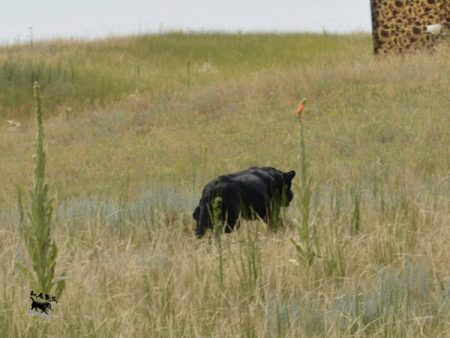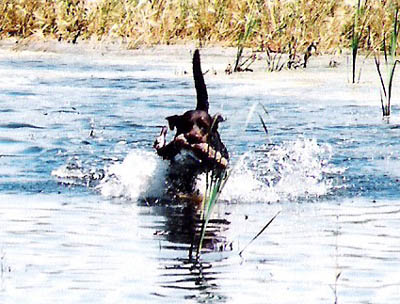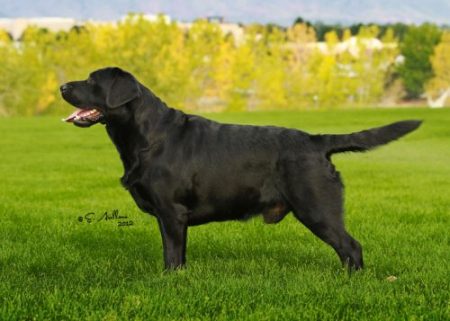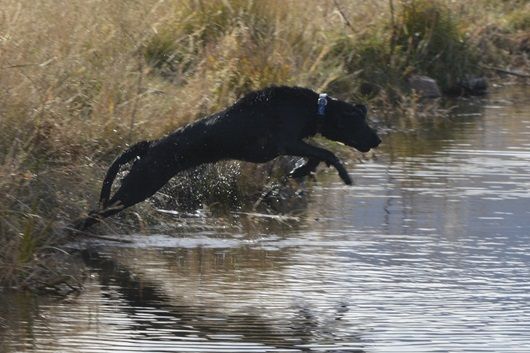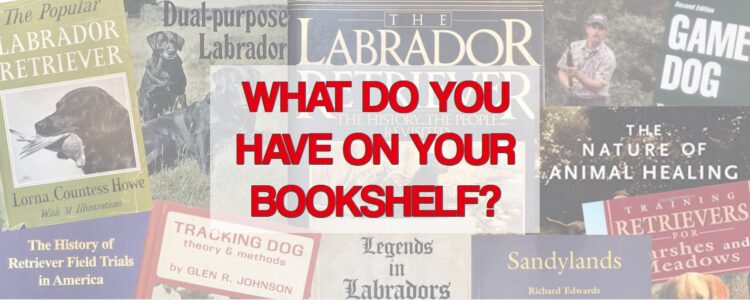
I was dusting my shelves and noticed I have a LOT of books about dogs in general and Labradors in particular. My library isn’t limited to Labs, but also includes books on other breeds, plus books on training, care, and breeding. Here’s a list to help you decide what books you need in your library.
Labrador history
The Labrador Dog – Its Home and History (1936)
– Lord George Scott and Sir John Middleton
This is one of my favorite books! It was written by Lord George Scott, brother of the 7th Duke of Buccleuch, and Sir John Middleton, the former Governor of Newfoundland. Lots of early history! Although the book’s cover isn’t in great shape, the interior is well preserved. Even the fold-out pedigrees on tissue paper are intact.
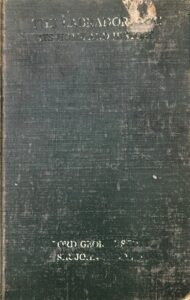
The Popular Labrador Retriever
– Lorna, Countess Howe
It’s a typical dog book, but having been written by one of the greatest proponents of the breed makes it special. She knew many of the early breeders and their dogs, often buying the best dogs she found. She wrote of the founding of the breed, the early dogs and their breeders. A story she included was about Lord Knutsford (then the Hon. Arthur Holland-Hibbert). He wanted to import a dog to add to his Munden strain and asked a friend for help. His friend didn’t find a dog, but was told “You will get a better one nearer home from a young fellow called Holland-Hibbert who lives at Munden, Hertfordshire.”
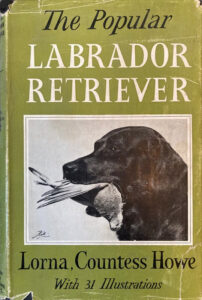
The Labrador Retriever – The History, The People
– Richard A Wolters
A comprehensive book about the Labrador Retriever. It starts with a detailed dive into the beginning of the breed based on the author’s review of early sources. He explains what sources he used and how they fit together, but it’s still like a jigsaw puzzle with some pieces missing. He continues onward discussing the Lab’s journey to England and Scotland, plus the times the breed nearly ended. Then the export to the US and breeders such as Jay Carlisle of Wingan put Labs on the path to popularity.
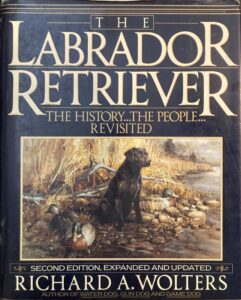
Other Labrador Retriever topics
The Dual-Purpose Labrador
– Mary Roslin-Williams
This book was published in 1969 by a woman who knew Labradors. Any book by MRW is worth reading and this one doesn’t disappoint. If you can find a copy available, snap it up. Then be sure to read the chapters on Type and Conformation. You may also want to listen to one of her lectures as well.
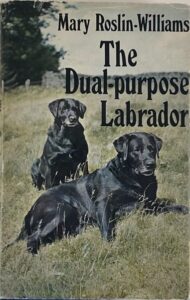
Reaching for the Stars
– Mary Roslin-Williams
Previously titled Advanced Labrador Breeding, this book is all about breeding. She discusses successful breeders and the qualities that make a good breeder. The part I found most interesting was her description of the stages a breeder goes through.
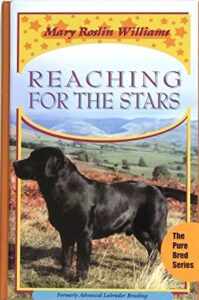
Legends in Labradors
– Nancy Martin
The author visited many important breeders, both in the UK and the US, and wrote a series of profiles. Included are Sandringham, Banchory, Ballyduff, Blaircourt, Cornlands, Hiwood, Knaith, Mansergh, Sandylands, and more from the UK. Plus Arden, Chidley, Deercreek, Earlsmoor, Franklin, Lockerbie, Nilo, Whygin, Wingan, and others from the US. The profiles aren’t long or in depth, but they give you a taste of why these kennels were so important.

The Book of the Labrador Retriever
– Anna K. Nicholas
Starts by discussing the origins and standards of the breed, and provides advice on caring for, showing, and obedience training Labradors. But what sets it apart from many breed books is the information on kennels in the US and Canada. Kennels included Beechcroft, Broad Reach, Campbellcroft, Chidley, Finchfield, Franklin, Killingworth, Kimvalley, Lockerbie, Mandigo, Rupert, Scrimshaw, Shamrock Acres, Simerdown, and Whygin.
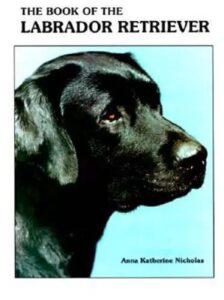
The Official Book of the Labrador Retriever
– Labrador Retriever Club Inc
Another comprehensive book about Labradors, although not so deep as Richard Wolters’ book, The Labrador Retriever. It has a section on history of the breed, but more interesting are the pedigrees and photos of Labs. Many of the highlighted bloodlines are from Europe and especially England and Scotland.

The Complete Labrador Retriever
– Helen Warwick
A lovely book that lives up to its name. If you want to learn about Labrador Retrievers – albeit at a high level rather than a deep dive – this is the book for you. Mrs. Warwick does a good job condensing the Lab’s history and yet keeping it readable. Other chapters discuss yellows and chocolates, Labs in other countries, showing, and breeding.
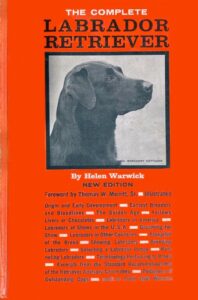
The Ultimate Labrador Retriever
– Heather Wiles-Fone
This is a large book with each chapter penned by an authority on that topic. Learn about Lab history, raising a puppy, training, showing, breeding, health, and more. And each chapter is complete enough to be its own book.
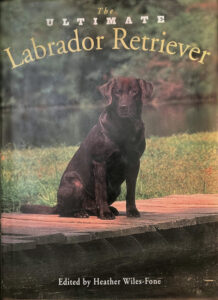
Sandylands
– Richard Edwards
A very in depth book about the Sandyland dogs – mostly Labradors, but also some other breeds. Follow along as Labs twine through Gwen Broadley’s life, from Juno through Tandy, Tweed, Mark, and many others. If you have any questions, the author is active on Facebook. And he also wrote a chapter in The Ultimate Labrador Retriever as did Marjorie Satterthwaite.
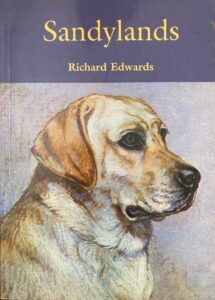
The Retriever Owner’s Encyclopedia
– Gwen Broadley
I stumbled upon this book recently and bought it because the author bred so many wonderful dogs under the Sandylands name. The book is more of a dictionary of dog terms, some simple and other lesser known terms such as haw, eclampsia, and timber. What I liked best was the sprinkling of photos including Sandylands Tweed of Blaircourt, Sandylands Tandy, Lockerbie Kismet, Knaith Banjo, and Reanacre Mallurd Thunder retrieving a fox. Although most of the photos are of Labs, there are also some of Goldens, Flatcoats, and Curly Coated dogs too.
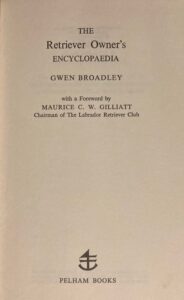
The Labrador Retriever
– David D Elliot
Numbered edition, mine is #18
A little book with basic Labrador care instructions, but what sets it apart are the number of photos of dogs from the Wingan kennel. Mr. Carlisle did an awesome job importing and breeding the best Labs. He was also very giving with his time to help other breeders. When he died he left his dogs to his trainer, David Elliot.
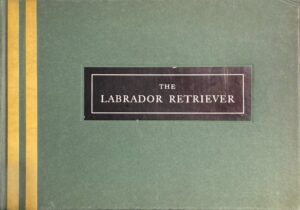
Life Magazine, Issue December 12, 1936
This issue included an article about Blind of Arden with an arresting photo of him on the cover. The article talked about his win at the “No. 1 U.S. Retriever Test” and included several photos. At that time, Labs were still new to the US.
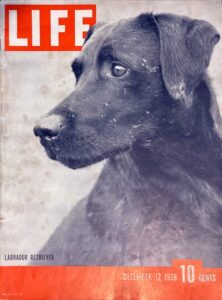
A Dog Owner’s Guide to Labrador Retrievers
– Marjorie Satterthwaite
This is a nice little introduction to Labs book, but I bought it for sentimental reasons. I met and talked with Mrs. Satterthwaite at the 2004 LRC National Specialty. She said some nice things as she went over my dog, even though we both knew Arwen wasn’t a show dog. We talked again at the hunt test when I gave her a photo of her judging my friend’s dog the day before. She passed away just a few years later.
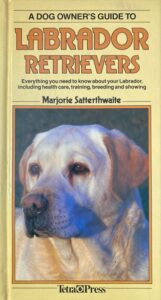
Health
The Nature of Animal Healing
– Dr. Martin Goldstein
I got to meet Dr. Marty when he was on his book tour. He’s such an inspiration! In his book he gives several ways to help your dog live longer and healthier. If you want to jump right into raw feeding, he tells you how to do it. Not quite ready to go all the way? He has tips to ease into it. I eased in because it’s hard to give your dog raw meat – bone and all – and wonder if it’s safe. But they loved it and I got over being fearful (mostly). I also think it helped my chocolate Lab live to 17 years old.
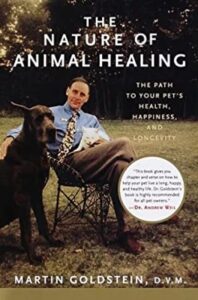
Keep Your Dog Healthy the Natural Way
– Pat Lazarus
This book is similar in many ways to The Nature of Animal Healing. It talks about feeding a natural diet and gives variations for females in whelp and another for puppies. Plus it explains why a natural diet is better. It also covers alternatives to vaccinations and the benefits of alternative medicine such as chiropractic, acupuncture and homeopathy.
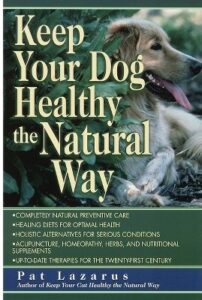
Field training and history
History of Retriever Field Trials in America
– Fred Kampo and Carolyn McCreesh
A signed, limited edition book that looks great on the coffee table. More than that it provides a detailed glimpse into the start of field trialing in the US. It includes information about the dogs’ performances, the handlers and owners, and the estates where trials were held. I love the amount of photos included and the depth of detail. However I wish that sub-headings had been used to make it easier to find specific information.
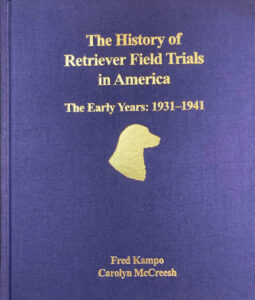
Mike Lardy’s training articles
– Collections 1 & 2
Collections of articles written by one of the most successful field trial trainers. Covers basic training through blinds, although it’s not very detailed. I recommend getting the first collection to get a good overview on field training. He also offers various videos that are more expensive, but can be a great help if you learn better visually. Most trainers I know use Lardy’s training progression or something very similar. Available through Total Retriever Training along with several great videos/DVDs.
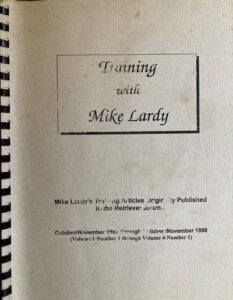
Tri-Tronics Retriever Training
– Jim & Phyllis Dobbs
Step-by-step program for retriever training which emphasizes “making it easy for dogs to learn.” Excellent section on the use of the electronic collar. There are also some concepts gathered from Schutzhund training. By the way, if you use Lardy’s program, skip this book or vice-versa. Trying to use both will confuse your dog.
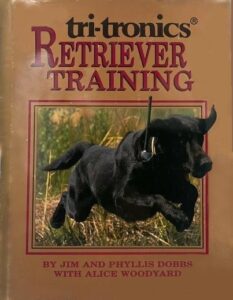
Training Retrievers for the Marshes and Meadows
– James B Spencer
A rather chatty book that starts with choosing a puppy and works its way through beginning to advanced blinds and marks. It does work, but you might want to pick up his other books that go into more detail on marking and running blinds.
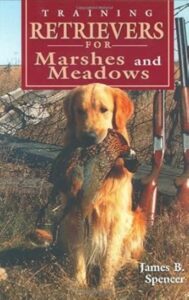
Training Retrievers to Handle
– DL & Ann Walters
Very in depth book, but worth reading to understand the steps involved in teaching a dog to handle.
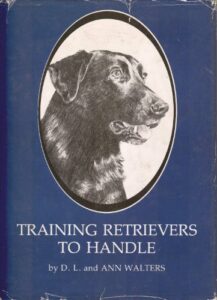
Retriever Training Drills for Marking
– James B Spencer
Because we can’t have a chat with our dogs and explain what we want – in a way they understand – we need drills. Some drills help teach a skill, others are used to refine a behavior. Drills are introduced during basics training and repeated over several training sessions. This book includes a variety of drills to help dogs pinpoint the area of the fall and go straight there.
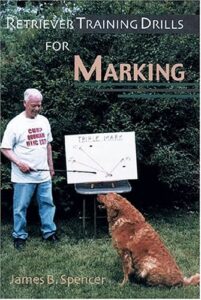
Retriever Training Drills for Blind Retrieves
– James B Spencer
Most drills have been developed by pros who need ways to teach dogs a concept. Some drills have been shared, while other drills have stayed within a group of people. For example, wagon wheel and 3-hand casting drills are well known. This book does a deep dive into a variety of drills including the purpose of the drill, equipment needed, precautions to take, and a step-by-step description.
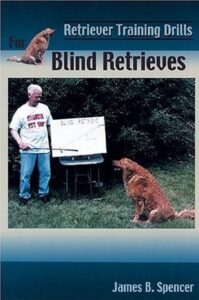
Retriever Training Tests
– James B Spencer
I wish more judges would read this book. Some judges have never hunted which leaves them at a disadvantage. They compensate by setting up a test similar to what they’ve seen as a competitor. Unfortunately they often don’t understand the ‘why’ of that set up. Other judges have lots of hunting experience which really helps them set up a realistic test. Sometimes, however, what happens in an actual hunt doesn’t transfer well to a testing environment.
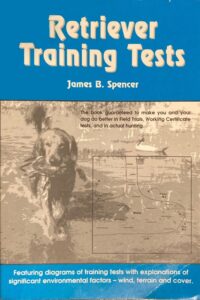
Water Dog
– Richard Wolters
A classic! Many dogs have been trained using this book, however there are newer books available. I think some of the new techniques are easier for the dogs to learn.
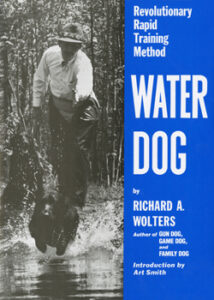
Game Dog
– Richard Wolters
Another good book and similar to Water Dog, but it focuses more on training for upland hunting. I like that it has a step-by-step method.
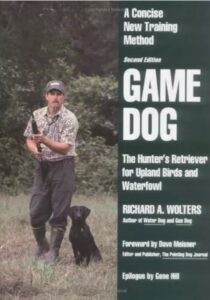
Other dog training books
Expert Obedience Training for Dogs
– Winifred G. Strickland
I have a couple of Bill Koehler’s books and his methods work. However I like more of a partnership rather than a master and servant relationship. Mrs. Strickland worked with her dogs and developed top obedience competitors that were happy and enthusiastic in their work. It also includes how to train tricks and basic tracking.
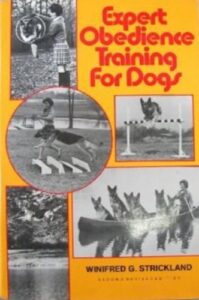
Peak Performance
– M. Christine Zink DVM
How to keep dogs fit and active by a consultant on canine sports medicine. Owners should learn their dogs’ health needs and how to keep them fit to compete successfully.
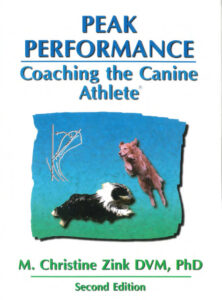
Beyond Basic Dog Training
– Diane L Bauman
A more recent book on obedience training that allows dogs to learn by trial and error. The dog isn’t corrected and so isn’t afraid of failing. I’ve heard many obedience trial champions have been trained using this method.
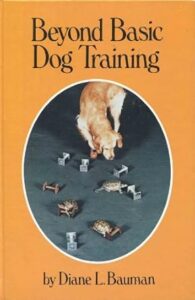
Tracking Dog Theory & Methods
– Glen R. Johnson
An oldie, but if you follow his methods your dog should be ready to run a TD test in about two months. It’s the best all-around book for understanding how to train a dog to track. It includes a schedule to train for TD and TDX titles, although it doesn’t include any information about the VST title.
Component Training For Variable Surface Tracking
– Ed Presnall and Christy Bergeon
Breaks down training for VST into specific skills. Not particularly easy to read, but it is the best book available on VST training.
Other books you need
The New Art of Breeding Better Dogs
– Kyle Onstott
This book does a good job of explaining how to combine genes to create a better dog. It includes an excellent chapter on inbreeding, line breeding, and outcrossing.

The New Knowledge of Dog Behavior
– Clarence Pfaffenberger
Research on how and when puppies are socialized makes a big difference in how well they can adapt to life with people. This led to discovering the critical stages of puppy development. If that time is missed the puppies may never be able to bond with people.
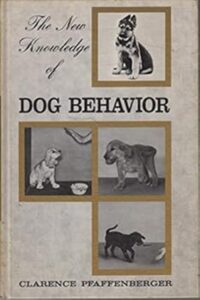
I also have a lot of yearbooks and compilations:
The Labrador Retriever Club (UK) Stud Book and Record of Field Trials 1949 – with an introduction by Lorna, Countess Howe
The Labrador Retriever Club 1931-1956
The Handbook of Amateur Retriever Trials, 1951-1961
Labrador Retriever Bench Records, 1967-1983
Retriever Field Trial Performances (I have almost all volumes, although I’m still looking for the 1979-1984 edition and volumes from 2009 forward.)
Some of the books are rather old and out of date, but there’s still good information in them. Just don’t get me started on magazine collections!
What are YOUR favorite dog books?
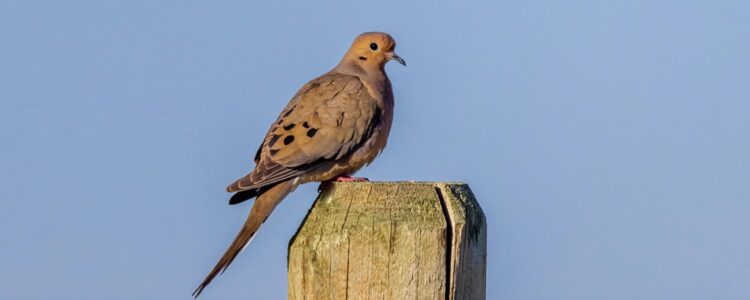
Some hunting trips take quite a bit of preparation and a hefty bank account. In that category are an African safari, wing shooting in South America, or a caribou hunt in Canada. Not so with dove hunting which can be as simple as having a shotgun, some shells, and a place to hunt. Some people will want more and that’s okay, but not necessary.
Read on for tips for a successful dove hunt.
Getting started dove hunting
First you need to decide on the what. When considering dove hunting, most people think of the mourning dove. They’re small, fast and quite tasty. Their season generally starts on September 1st.
Mourning doves are brown with black spots on their wings and have a long, pointed tail.

Mourning dove. Image courtesy Pixabay.com
White-winged doves are slightly larger than mourning doves, but they otherwise look very similar. Watch for a white bar on the upper wing surface and a rounded, rather than pointed, tail.
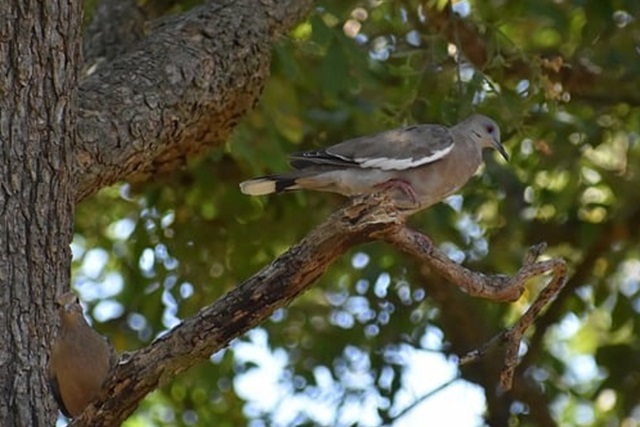
White-wing dove. Image courtesy Pixabay.com
You can hunt both species provided the combined total doesn’t go over possession and bag limits.
Another option is hunting the invasive Eurasian collared dove. They’re bigger than the mourning dove, have a pale gray body, and a black collar on the nape of neck. Also look for a black bill and a squared tail.
Eurasians are found almost everywhere, and in some states you can hunt them year-round with no limits.
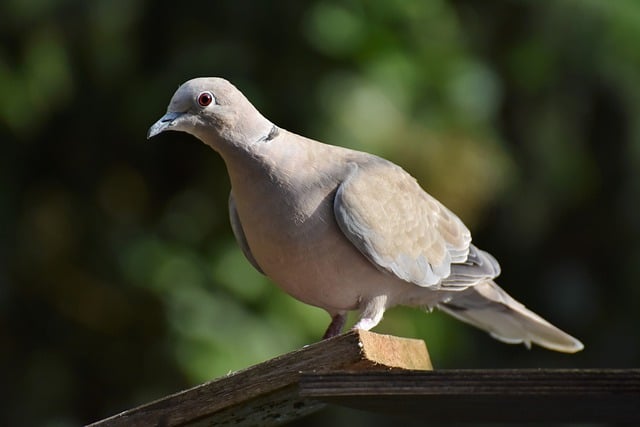
Eurasian dove. Image courtesy Pixabay.com
Next in consideration is the where. Doves need three things – food, water, and gravel. A place to roost nearby is also a consideration.
They love wheat stubble and fields with harvested sunflowers, but any place with seeds can attract them. They’ll even stop at ponds with exposed banks and weed cover. Unfortunately many of those places are not available to hunters. Some might be private property and others could be too close to houses.
You can ask farmers if you can hunt on their property. Also check for state-managed fields that are publicly-accessible. Another option is a hunting club. Members can schedule a hunt on the club’s property which can be thousands of acres.
Lastly is the when. Mourning dove season starts on September 1 in most states, but check with your state to be sure. Eurasian doves can be hunted year round in some states. There are also other dove species which varies by state. Check state websites or ask for a rule book at your local hunting store.
Dove hunting equipment and gear
Hunting license
Mourning doves are protected under the Migratory Bird Treaty Act so you’ll need a valid hunting license with a Migratory Game Bird Endorsement. Every hunter must also enroll in the HIP (Harvest Information Program) and carry proof of enrollment.
Shotgun
Federal regulations require repeating shotguns (pump and semi-auto) be plugged so they can only hold three shells. That includes one in the chamber.
For dove hunting, use an improved cylinder or modified choke for a wider, more open, pattern. A tight pattern makes it harder to hit fast-flying birds, and if you do connect it could tear up the bird.
If you use a double barrel, shoot with an improved cylinder first. Then for a second shot use a modified choke to hit the bird at a longer distance.
Shells
Smaller shot sizes, such as 7, 7-1/2, or 8, are best for dove hunting. These smaller sizes will put more pellets down range which should help you harvest more birds.
Doves are fast and rather acrobatic, so bring more shells than you think you’ll need. A good estimate is five shells for each bird you’re allowed to harvest, so 75 shells for a limit of 15 birds. Better to have too many than not enough!
Also be sure to check state regulations regarding the type of shot allowed. Steel shot may be required on state land or if you’re shooting over water. On private land, ask the property owner if he has a preference.
Clothing
A great thing about dove hunting is you don’t need a lot of expensive equipment or special clothing. I usually wear a pair of jeans and an earth-tone or camouflage shirt. Doves seem more concerned about movement than clothing.
If it’s a long walk in to your hunting spot, make sure your boots are well-fitting and broken in.
Wear a bird vest, preferably in blaze orange for your safety in the field.
Eye protection
Rose or amber-tinted glasses will protect your eyes from UV rays and stray birdshot. They also improve your depth perception so you can separate targets from the background.
Hearing protection
This is a must-have. One unprotected gunshot can cause significant damage to your hearing. And once your hearing is damaged, it can’t be repaired.
There are a variety of options available from the disposable foam earplugs to custom fitted hearing protection. Learn more about the options for ear protection in this Complete Guide. Choose what works best for you.
Sunscreen
Although a lot of other hunting seasons are in the cooler months, dove season is often warm and sunny. Be sure to apply sunscreen on any unprotected skin.
Water
Bring enough for you and for your dog.
Beyond the must-haves, here are some nice-to-haves
A trained retriever
A well-trained dog can make your time in the field so much easier. When my friend, Tom, and I hunted along a creek bed the birds seemed to know where we were and took a detour. So I sent my Lab up on the bluff to the west of the creek.
She not only handled her main duty of fetching the birds we shot, but also worked as a “traffic cop.” Her presence on the bluff had the birds flying along the creek bed and very near to us.
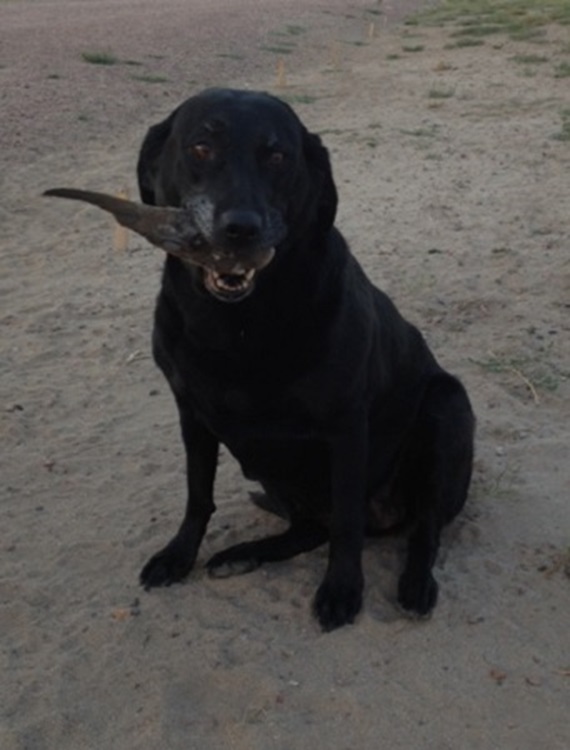
Having two dogs retrieving got the birds out of the field quickly. They also made it possible to find downed birds where the grass was thick and deep. However you must be aware of where each dog is at all times. In thick cover you might add a bell or beeper to their collars.
The best dove hunting dogs are trained well. Skills needed include:
- steadiness
- marking ability
- familiar with gunfire and whistle commands
- experience retrieving upland birds (very different from waterfowl).
If your dog hasn’t hunted doves before, set up a mock hunt that simulates what the dog may experience. If you normally fill your 15 bird bag limit, do a lot of shooting & retrieving. Or if you usually only see a few birds then include lots of sitting and waiting.
Safety tips for dove hunting with a dog
If your dog is young and/or inexperienced, know that your attention will be divided. If he’s not rock solid steady, keep him on a leash while anyone is shooting.
Because it’s often quite warm during dove season, make sure your dog doesn’t overheat. Provide water and as much shade as possible.
Also be aware of potential dangers in the field, such as snakes, barb-wire fences, holes, and snags. Several years ago there was a fast-moving dog that hit a hole, somersaulted, and broke his back.
Your dog’s safety is more important than shooting another bird.

My good friend, Tom, and his yellow Lab, Woody.
A bumper for your dog
Sometimes the birds just don’t cooperate. When that happens, toss the bumper for your dog to retrieve.
Forceps
Walking in to our spot on the creek required crossing a large patch of yucca and prickly pear cactus. The dogs were excited to go, but not so happy about the stickers. Before our next hunt we bought some forceps to pull the spines without pricking our fingers.
Other suggestions I’ve heard are to brush white glue or rubber cement over the stickers, let it dry and peel off. Using duct tape may also help.
Decoys
Doves respond well to decoys and they’re not that expensive. Cabela’s offers some sets of 4-6 decoys for $20-30. Motorized decoys will cost $50 or more, but it’s worth the expense as doves decoy to them from a distance.
For a really inexpensive DIY set of decoys check out the article from Colorado Outdoors Magazine. Then use some clips to attach them to fencing and branches.
Blind to hide behind
Where I hunt there are lots of trees to hide behind so I don’t bring a blind. I do have a small one I made out of gunny sacks and a couple of hot wire poles in case I ever need it. But if you’d rather not DIY there are plenty for sale online.
Something to sit on
Depending on how far you have to hike in, you may want something to sit on or decide it’s not worth the trouble.
I like a bucket with a cushioned swivel top. It makes it easy to carry what I need including ammo, water, sunscreen, and plastic bags.
Knife or game shears, resealable bags, and an ice-filled cooler
Everyone has their own way to field dress doves, but it’s important to get them cooled down as soon as you can. I put them in a bag and pop them in the cooler until there’s time to dress them out.
Once the action slows down, I’ll pluck the breast feathers and peel off the skin. Then cut the breast from one of the wings, leaving a fully feathered wing attached. It’s quick, easy, and few feathers are left to fly around.
Other people will pluck the entire bird after removing the head, feet, wing tips, and entrails. The trick, they say, is to pluck the birds while they’re still warm. Just remember you may need to prove the bird’s species. The easiest way is to leave a fully feathered wing attached.
Preparing for your hunt
Even if you have a favorite spot, check everywhere you might hunt in the coming season. Something about the location might have changed causing doves to avoid it. Land ownership could have changed as well.
Drive around areas that doves might like. Look for birds sitting on power lines near croplands or flying in or out of a field. Watch for doves on gravel roads where they can consume grit to help digest their food.
Although their natural foods are sunflowers, foxtail, and grasses with small seeds, they are also attracted to croplands.
Also look for a water source nearby. In warm weather doves will fly to water several times in a day. The water can be as small as a puddle, but look for water that doesn’t have a lot of vegetation around it. Doves are more vulnerable on the ground and prefer a good field of vision.
When you find a likely area, ask the landowner for permission if it’s private property. Or if it’s state land, check the regulations.
You might also try contacting the local conservation officer. He may know of food plots planted for upland game on state lands. Or he could suggest landowners for you to contact. If the landowner gives you permission, you should thank him with at least a note or a few birds you shot on his property.
Hunting methods
Pass-shooting
Doves like to feed in the early morning and in the afternoon. If you’re in the right place at the right time, you’ll see them moving from feeding ground to water and then to roost. During the middle part of the day, they’ll mostly hang out on power lines or in trees.
Things to keep in mind:
- Doves like to be part of a flock. If you see a few birds, wait a bit to see if others come along. Watch where they go. Look for a place along that flight line where you can set up.
- Best times to see doves are just before sunrise and about an hour before sunset. In the morning, they’re heading out to feed. In the evening, they’re going to get a drink.
- Pay attention to the prevailing wind.
- Look for a place where you can blend in, rather than being silhouetted against the skyline. And then stay still while birds are flying.
- As seed eaters, doves will walk around on the ground looking for seeds. And they prefer open ground so they can see approaching danger.
- They also want to be fairly close to water. Generally they’ll eat in the morning and afternoon, then get a drink, and finally head for a roost.
- Another place to check are areas with sand or gravel. Doves will visit these areas after feeding because they need grit to grind down the seeds.
- Doves are fast fliers so you need to aim where they’ll be and not where they are. Focus on the bird’s head and add a four to six foot lead. Increase or decrease the lead until you find your sweet spot. Be sure to continue swinging through the bird as you shoot.
Decoying doves
Doves will decoy. One or two spinners can be seen from a distance and will bring doves in close. Wing flapping decoys look more natural, but can’t be seen as far.
Adding some static decoys set out to look like they’re feeding, drinking, or roosting will help incoming birds think it’s safe. Just make sure the decoys are easy to see.
Even silhouettes clipped onto tree branches and fences can work.
However when shooting over decoys, be aware that your shots may be lower. What can be hit with a low shot? A building? Other hunters? A dog?
Regulations
Be sure to read a copy of your state’s regulations.
You can’t hunt over an area where “bait is present that could lure or attract birds ‘to, on, or over areas where hunters are attempting to take them.'” So watch for grain or other feed in the area where you plan to hunt. If it’s due to agricultural planting and harvesting, you should be fine. However if the grain is in piles, you should find another place to hunt.
Some tips from Arizona Game & Fish:
- Don’t shoot within 1/4 mile (440 yards) of an occupied structure while hunting unless you have permission
- Don’t shoot from, across or into roads or railways
- Don’t leave shotgun shells or other litter on the ground
- Don’t hunt over water all day — allow time for livestock to access water
- Don’t consume drugs and/or alcohol while hunting or handling firearms
Terms you should know
“Motorized vehicles. You cannot hunt migratory game birds from or by means, aid, or use of any motor vehicle, motor-driven land conveyance, or aircraft (if you are a paraplegic or are missing one or both legs, you may hunt from a stationary car or other stationary motor-driven land vehicle or conveyance).
“Shooting hours. You cannot hunt migratory game birds except during the hours open to shooting.
“Closed season. You cannot hunt migratory game birds during the closed season.
“Daily bag limit. You can take only one daily bag limit in any one day. This limit determines the number of doves you can have in your possession while in the field or while in route back to your car, hunting camp, home, or other destination.
“Wanton waste. You must make a reasonable effort to retrieve all doves that you kill or cripple and keep these birds in your actual custody while in the field. You must immediately kill any wounded birds that you retrieve and count those birds toward your daily bag limit. Your birds must remain in your possession while in the field. You cannot give your birds to another person in the field regardless of whether or not they are properly tagged.
“Tagging. You cannot put or leave migratory game birds at any place or in the custody of another person unless you tag the birds with your signature, address, number of birds identified by species, and the date you killed them.
“Dual violation. A violation of a State migratory game bird regulation is also a violation of Federal regulations.
“Migratory Bird Harvest Information Program (HIP). Each hunter is required to enroll in the HIP and carry proof of such enrollment.
“Protected birds. Federal law prohibits the killing of non-game migratory birds. Protected birds that you may encounter while dove hunting include songbirds, eagles, hawks, owls, vultures, killdeer, nighthawks, herons, egrets, and woodpeckers.”
After the hunt
Care for your dog
Run your hands over your dog’s face, ears, body, legs (including “arm pits” and groin) and between his toes. You’re looking for injuries, bumps that could be ticks, foxtails, and cactus or other stickers.
Be sure to offer water as well.
Finish prepping birds
If you’ve already started preparing your birds, just cut off the remaining wing and clean the breast. Otherwise finish preparing your birds whether you’ll cook the entire bird or just the breast.
I like the time-tested recipe – wrapped in bacon with a slice of jalapeño. Although I admit I like a milder pepper and often use a poblano instead.
Doves are tiny but tasty. The breasts are dark red meat that tastes like beef, or like little duck breasts, if you cook it rare. Breasting a dove is simple and takes seconds, leaving you with about an ounce of meat per dove. You can leave the meat on the keel and make the ever-popular dove popper, a cream-cheese and jalapeno-stuffed breast wrapped in bacon, or you can filet those two bites off the breast and use them in a kabob or stir-fry. And, again, the meat will be delicious rare, and unpleasantly liver-like if you cook it too much.
If you’d like something a little different, check out Hank Shaw’s dove recipes.
Final thoughts
Dove are quick, fun, and tasty. I look forward to September not only as the start of hunting season, but also for soon-to-be cooler weather.
Enjoy your time in the field, whether it’s with hunting buddies or just your favorite dog.
Header photo by Aaron J Hill/Pexels
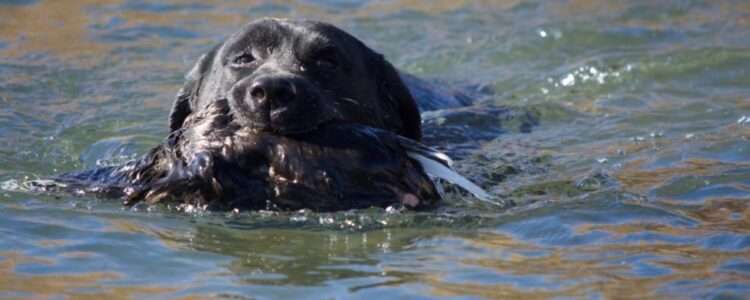
After a rewarding hunting season, you might find yourself looking for more challenges and opportunities to bond with your dog. That’s where hunting tests come into play.
Some hunters may feel their dogs are skilled enough without needing titles and ribbons, but hunting tests offer much more.
It’s a great way to keep your dog active and in sync during the off-season. Plus, it’s an opportunity to showcase your dog’s abilities and to connect with others who share the same passion. Many lifelong friendships are forged while training and competing.
With your curiosity piqued, I’ll bet you’re wondering, “What can I expect at a hunting test?” Well, grab your favorite beverage and settle in to learn about the fascinating world of retriever hunting tests.
History of Retriever Hunting Tests
Retriever breeds have competed in field trials in the US since the 1930s. In the beginning, the tasks required of the dogs were not much different than we see in hunting tests today. But as the dogs got better, the tasks got harder. And as the tasks got harder they became less like hunting.
Eventually, hunters wanted a way to test their dogs’ actual hunting abilities. A few different programs were tried but with little success.
Then in 1979, Omar Driskill started a “gun dog club” in Louisiana that became very popular. A few years later Bill Tarrant noted field trials were producing dogs that were different than what the average hunter wanted. And Richard Wolters (author of “Water Dog”) wrote an article asking if there’s a need for the hunting retriever movement.
Table of Contents
History of Retriever Hunting Tests
The Basics of Retriever Hunting Tests
Junior vs Started Retriever Hunting Tests
Senior vs Seasoned Retriever Hunting Tests
Master vs Finished Retriever Hunting Tests
Master National vs International Grand Hunt
So hunting enthusiasts got together in New York to discuss forming an organization for hunting retrievers. Present were trainers, writers, and representatives from AKC and UKC.
First Hunting Tests
Based on that meeting, the first hunting test was held in 1983 under the North American Hunting Retriever Association (“NAHRA”) rules.
About a year later the Hunting Retriever Club (“HRC”) was formed. Shortly after that the American Kennel Club (“AKC”) held its first retriever hunting test. Because of their common start, the rules and the stakes offered are very similar. The tests are not competitive so the dogs pass or fail on their own merits. There are three basic levels with titles in each organization.
In 1985, the first year that AKC licensed tests, there were 13 events with 681 entries. By 2005, there were 341 events with nearly 35,000 entries.
It wasn’t long before owners who had titled their dogs in Master or Finished, wanted something more to achieve. This led to the development of the Master National (affiliated with AKC) and HRC’s International Grand.
Something the original organizers probably didn’t consider was as training methods improved the tests would gradually became more difficult. A Junior stake 20 years ago was very different from tests today despite the rules changing very little. This seems to be the case in both organizations, but it’s a bit more apparent in AKC tests.
The Basics of Retriever Hunting Tests
The AKC and the HRC offer similar hunting tests. Each offers three levels for weekend hunt tests, plus a more difficult annual (twice annually for HRC) test. HRC also offers an Upland test.
Clothing
AKC requires handlers to wear “dark or customary hunting attire”.
HRC requires the handler to wear ALL camouflage – shirt with pants / shorts / or skirt. Hats and waders, if worn, also need to be camo.
Titles
Titles earned in AKC hunt tests are listed after the dog’s name, while HRC titles are listed before the name.
The levels are:
| AKC | HRC |
| Junior / JH | Started / SHR |
| Senior / SH | Seasoned / HR |
| Master / MH | Finished / HRCH |
| Upland / UH | |
| Master National / MNH | International Grand / GRHRC |
The rules are similar, but not exactly the same. Be sure to check before entering and running your dog. You should read the rule book and highlight important information so you can find it easily when you have questions.
Allowed breeds:
You’d think retriever hunt tests would be for retrievers, but both organizations opened the tests up to many hunting breeds. In a nutshell, they allow retrievers, plus Standard Poodles and a variety of spaniel and pointer breeds.
Spayed/neutered dogs and dogs that would be disqualified in the show ring are also welcome.
AKC restricts the hunt tests to dogs over six months, individually registered (not just litter registration), and of eligible breeds. There are special rules for entering imported dogs that are not yet registered with AKC.
HRC limits the tests to hunting breeds on their list which does not include dilutes (the “Silver Labs“). Note: if a dilute dog is entered in a hunting test the test committee should be notified. HRC does not consider dilutes a hunting breed and are disqualified.
Joining a club
You don’t have to be a member of a club to enter, but having a group to train with can be helpful.
Find a local AKC club (select ‘Hunting Test’ and your state)
Find a local HRC club (click on ‘State’ to group clubs by state)
Join HRC (national club) It’s not expensive and you get an informational magazine six times per year. There are additional fees in HRC if you are not a member of the national club or if your dog is not UKC registered.
Click to start the UKC registration process. If your dog is AKC registered, have that information handy to fill out the UKC form.

Click to watch a video of Omar Driskill talking about the start of hunt tests.
Junior vs Started Hunting Tests
The Junior and Started hunting tests are very similar. They include two series – a land series with two single retrieves on land and a water series with two single retrieves on water.
Both allow you to hold your dog at the line. In Junior, you can loop a slipcord through the collar which must be a flat buckle collar. Or you can hold the dog by the collar. In Started, you can hold the dog by a collar, leash, or line around its neck. (As a judge, I always recommend holding your dog. If you don’t and your dog breaks, he will likely fail.)
A change in AKC rules as of August 1, 2023 allows handlers to speak quietly to their dog and be allowed to touch their dog for reassurance or positioning. This is only allowed at the Junior level. Handlers can speak quietly to their dog in Started as well.
You don’t handle a gun in AKC and rarely handle one in HRC. Although in HRC you can opt to shoulder and shoot a popper. However in that case you cannot hold your dog and you are also judged on gun safety.
There are some differences
You’ll need a whistle in either test and a duck call in Started. Although the AKC premium usually says to bring a duck call, many judges don’t require it. You should, however, have your own duck call, know how to blow it, and have your dog used to it. Just in case.
Distances
The maximum distances are different. In Junior, the test distance on land and water “should not normally exceed 100 yards.” But in Started, the “maximum land test distance will not exceed seventy-five (75) yards, but may be less.” The wording is the same for water, but the maximum distance is 60 yards. Some judges like to push the distance out further, particularly in AKC where the wording is not as definite.
Sit or Stand
You’ll often stand beside your dog in Junior. Whereas in Started you’ll generally sit on a bucket beside your dog. Be prepared to run your dog from either position.
Entry Limits
Started is limited to 50 entries per flight. Most HRC Started tests don’t fill, but enter as soon as entries open if you want to be sure. Many clubs allow “walk ups” (entering the morning of the test), but only until the limit is reached. Junior entries are rarely limited, however entries are only accepted until about two weeks before the test.
Birds
Ducks are often used, but occasionally you’ll see a mixed bag of ducks on water and upland birds on land.
In Junior, you’ll have at least one shot flyer (unless using live ammunition is prohibited by law or the land owner). A live bird will be thrown in the air and shot. Depending on the gunners, that could mean a dead bird, a lightly-hit runner, or a hard-hit bird not be suitable for the table.
In Started the birds are usually humanely killed on the morning of the hunt test. Often gas is used and new dogs can be unsure of that smell, but the scent wears off quickly. If your dog has never run an HRC test, you can ask to run a bit later.
After the bird lands you must wait for the judge to release you in a Junior test.
But in Started, you’re allowed to send your dog as soon as the bird hits the ground or water. However, you should wait a couple of seconds so there’s no question the bird landed before you sent your dog.
Confusion
Sometimes a dog will start toward a mark and stop within about 15 feet. In Junior, the dog can be recast because he may be confused whether he was actually sent to retrieve. This is different from a dog that goes to the area of the fall, fails to find the bird, and comes back to the handler. However in Started you can cast your dog a maximum of two times from the line per bird. The rules don’t specify a limit on how far the dog can go or how long he can hunt.
Delivery
Your dog must deliver all birds to hand in Junior. If he drops it, perhaps to shake off water, you can tell him again to fetch it. You may have to tell him several times, but the more commands, the lower his score. However if he’s unwilling to release the bird he’ll be scored low in Trainability, even to the point of failing. In Started, your dog must deliver to your immediate area, but not necessarily to your hand. If the judges don’t explain their measurement for “your immediate area” you should ask as it’s not clearly defined. Generally, judges will allow you to take a long step to pick up the bird.
Second series
In Junior, the judges will confer after completing the first series. A dog that both judges have failed is not called back to run the second series. The judges will list the dogs (by number) that are passing and the marshal will advise handlers of the “callbacks.” In Started, you can continue to run your dog even if you failed the first series with some exceptions. Those exceptions include a gun safety violation, dog fighting, or a handler ejected for bad behavior.
HRC awards five points per pass with 20 points required for the Started (“SHR”) title. In essence, both AKC and HRC require four passes in Junior or Started for a title in that organization. Passes from a higher level do not count toward the Junior or Started titles.
Watch an AKC Junior Hunting Test or an HRC Started Hunting Test.
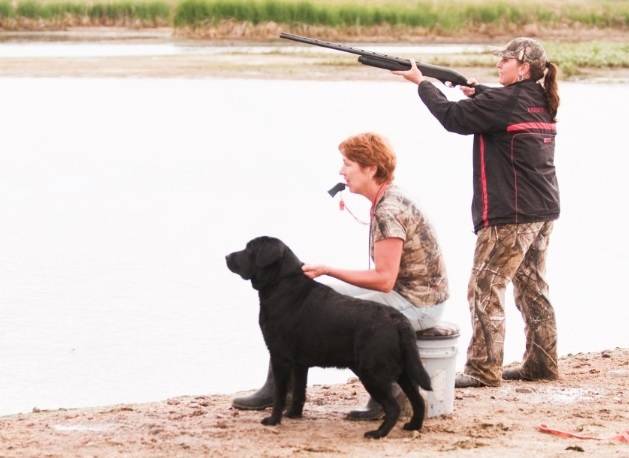
Senior vs Seasoned Hunting Tests
Although the basics are similar, there are a lot of differences between Senior and Seasoned tests.
What is similar
Both include double land and water marks, a land blind and a water blind, but they’re run differently.
Senior has two series: land double and blind, water double and blind, plus at least one diversion shot, a walk-up to start one of the tests, and an honor. Dogs that fail the first series are not called back to run the second series.
Seasoned has five tests: a walk-up, a double land mark, a land blind, a double water mark, and a water blind. There is also a diversion bird.
Pretty similar except Senior has a walk-up to start a double while Seasoned does the walk-up separately.
Collars
Dogs run without a collar in both organizations, but when the collar or slip lead is removed is different.
In Senior it’s removed before going to the line from the final holding blind. The dog is put back on a lead when the series is finished and the dog and handler are behind the judges. You may be asked to put your dog on a lead to honor if your dog has failed the test.
For Seasoned, the dog goes to the line on a lead and the lead is removed before starting the test. If the dog runs the marks and blind from a different line, the dog is put back on a lead when moving to the next line. The dog is also put on a lead when the series is finished.
Handling the shotgun
Handlers in both organizations must shoulder the shotgun. Senior tests have a non-operational gun and there is no shooting from the line. Seasoned tests require handlers to shoulder, aim and shoot a popper at each bird.
Blinds must be outside of the marks and delivering the bird to hand is required in both stakes.
Distance
In Senior, the test distance on land and water “should not normally exceed 100 yards.” While in Seasoned, the “maximum land test distance will not exceed one hundred (100) yards but may be shorter.” The wording is the same for water, but the maximum distance is 75 yards. The blinds “will not exceed sixty (60) yards…”
Diversions
In Senior, diversion shot(s) must be used and diversion bird(s) may be used. Switching or returning to an old fall in Senior is a failure. Seasoned requires a diversion bird that “can be thrown after the walk-up, blind, or last retrieve of a double mark.” Switching to the diversion bird is a mark-down, but not a failure in Seasoned.
Casting
Seasoned can be cast from the line two times per bird, but in Senior the dog can be sent more than once only in cases of confusion. There is no second chance if the dog doesn’t go when sent for a blind retrieve.
Popping
Popping isn’t penalized in Seasoned. It is a mark-down in Senior, earning a bigger penalty the more the dog pops.
Honoring
Senior dogs must honor a working dog at least once. There isn’t an honor in Seasoned.
Entry limits
Also, Seasoned limits the number of entries to 40 per flight. If you want to make sure you can enter check for when entries open and enter online as soon as possible after that. I’ve never seen an AKC club limit Senior entries. However if there are too many entries to finish the test in one day, you may have to come back. If the test starts on Sunday, that means coming back on Monday.
Titling
If a dog has a Junior title, four passes are required for the Senior title. Without a Junior title, five passes are required.
The Seasoned (“HR”) title requires forty (40) points for a title and can include points from Started (5 points per pass), Seasoned (10 points per pass), or Finished (15 points per pass). However, only 10 points from Started can be counted toward the Seasoned title. Basically, if you have a couple of Started passes you need three Seasoned passes. Otherwise, four Seasoned passes are needed for the HR title.
Watch an AKC Senior Hunting Test or an HRC Seasoned Hunting Test.
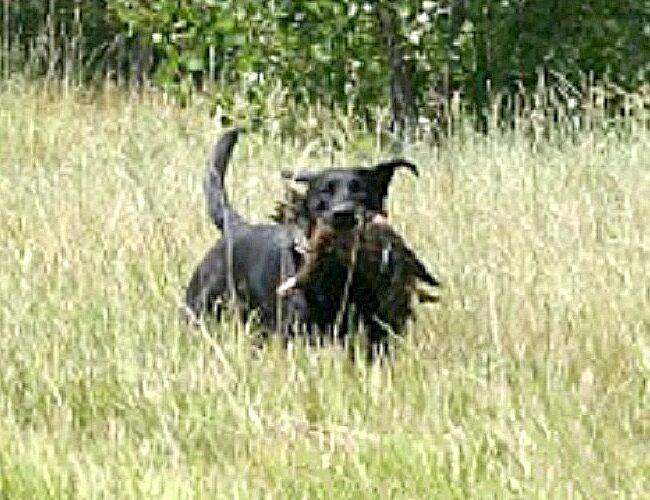
Master vs Finished Hunting Tests
In these tests, almost anything goes. There will be multiple marks and sometimes multiple blinds, diversion shots and/or birds, plus an honor and/or a walk-up. Dogs might run from a boat or from beside a layout blind. There may be a mixed bag of birds (for example, retrieving ducks and pheasants in the same series). Handlers of the working AND honor dogs may have to shoot at birds. There might be a “poison bird” (a bird the dog may not retrieve until he has done another task).
Luckily there are limits to what the judges can require.
What is similar
Dogs are taken off lead before leaving the holding blind. They are judged until the series is finished and the dog and handler are behind the judges. An exception is made when they’ve failed the test and have to honor on lead.
Although Junior or Senior entries aren’t usually limited, Master can be – and often is – limited. Clubs can choose to limit the number to 66, 100, 132, or 200 entries or can have unlimited entries.
HRC limits the number of Finished entries to 30 dogs per flight. Many clubs schedule a second or third set of judges to run more flights so more dogs can enter. Even with additional flights scheduled you should enter early as most tests fill up quickly.
Master test requirements:
- has three series – a land series with multiple marks, a water series with multiple marks and a land and water series with multiple marks
- at least two of the multiple-marking situations must have three falls before the dog is sent to retrieve
- a land blind and a water blind with at least one double blind
- dogs must honor at least once
- there must be a walk-up, diversion bird and/or shots at least once
- will be scheduled to run over a minimum of two consecutive days
Finished test requirements:
- has four tests – a land triple, a water triple, a land blind, and a water blind – may be required to retrieve in an established sequence
- at least one of the triples must include an honor
- the blinds may or may not be included with one of the triple retrieves
- there must be a diversion as the dog returns from any retrieve
- the test is completed in one day
Test distances
Master on land and water, shall not normally exceed 150 yards.
Finished land distance will not exceed 150 yards, but may be shorter. Water distance will not exceed 125 yards, but may be shorter. Blind retrieve distance will not exceed 100 yards.
Switching
In Master it shall be scored low, to the point of failing. But in Finished, switching to a diversion bird is a fail.
Controlled break
The Master dog fails, while the Finished dog may be failed for a controlled break or excessive, consistent creeping.
The use of the shotgun
A Master handler “shall always carry and shoulder an empty shotgun except when honoring the working dog or when running a blind.”
A Finished handler “must shoulder the shotgun, aim, track, and shoot at the top of the arc of the thrown bird.”
Titling
If a dog already has a Senior title, five passes are required for a Master title. Without a Senior title, six passes are required.
A Finished title (“HRCH”) requires 100 points and points can be earned in Started (5 points per pass), Seasoned (10 points per pass) and/or Finished (15 points per pass). However, at least 60 points must be earned in Finished with a maximum of 40 points from Seasoned. If 10 points were earned in Started, then a maximum of 30 points can come from Seasoned.
Watch an AKC Master Hunting Test or an HRC Finished Hunting Test.
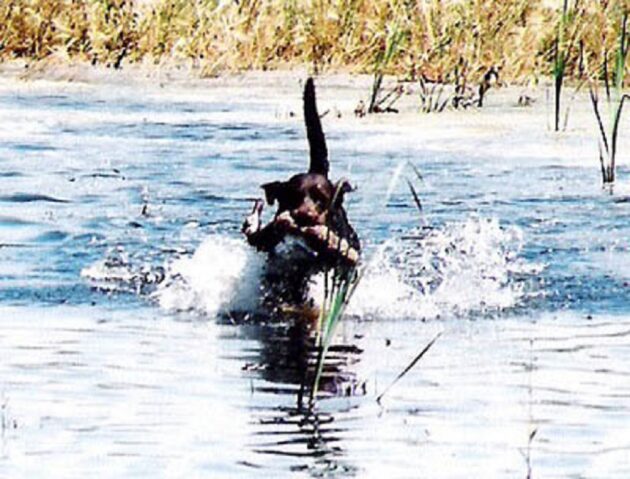
HRC Upland Hunting Tests
The Upland Hunter stake is designed for dogs trained to the Finished level. However dogs don’t need to have any titles before entering an Upland test.
There’s a simulated walk-up followed by a quartering test where the dog will locate and flush at least two birds. The handler must aim, track, and shoot a popper at birds his dog flushes, keeping gun safety in mind. Once the handler has fired a shot, the official guns may shoot the bird, if it can be done safely. The dog must retrieve any birds shot for him and must honor another dog.
Each passing score earns the dog 10 points with 40 points needed to earn an Upland Hunter (“UH”) title.
Watch an HRC Upland Hunting Test.

Master National vs International Grand
These events are very different from weekend hunting tests. Dogs must qualify to enter, their work is held to a higher standard, and the events are run over several days.
To qualify for the Master National, the dog must have passed six Master tests between August 1 of the year before the event and July 31 of the event year. There are exceptions for dogs running tests exclusively in Alaska or Canada. A dog that qualified at the previous year’s Master National needs four Master passes to enter. A dog that has the MNH title doesn’t have to requalify.
The Master National Hunter (“MNH”) title requires three passes at the Master National Hunting Test. This title is in addition to the MH title. Unlike other hunting test titles, the owner must request the title certificate and pay a fee.
There is also a Master Amateur Hunting Title (“MAH”) which is similar to the MNH. Dogs must pass the Master Amateur Invitational Hunting Test three times to title. The owner must request the title certificate and pay a fee.
Two Grand Hunts are held each year and are open to retrievers that have earned a Hunting Retriever Championship (“HRCH”) title. There are five series. Two series have multiple mark land tests with a blind retrieve and at least one honor and a diversion. The two multiple mark water tests must have a blind retrieve and at least one honor and a diversion. The fifth series consists of an upland quartering test.
Prompt and precise responses are expected from retrievers at this level. Distances may be longer than any weekend hunt tests. A quad or delayed quad and/or having the dog retrieve in a particular sequence can be used.
Watch a Master National or an International Grand.
Are you ready to run a hunting test?
Entering a test
Tests in both organizations can be entered online. Go to EntryExpress for AKC or HuntSecretary for HRC. (Note: be sure to check both platforms if you’re running AKC as some tests are showing up on HuntSecretary.)
Entries are limited in HRC and Finished usually fills up very quickly. Seasoned might fill up quickly as well. AKC tests can also be limited but generally only Master. Be sure to check for when entries open and close.
You can run your dog in HRC without a UKC registration, but you’ll pay more, and your dog must be registered within 60 days of earning points or you forfeit those points. Note: it often takes a month or more to get your registration from UKC.
Preparing to go
Start a list of what you should bring so you’re not scrambling at the last minute. For example, you might include:
- a collar,
- leash,
- whistle,
- duck call,
- crate,
- bug spray,
- sunscreen,
- sunglasses,
- rain gear,
- jacket,
- rubber boots and/or waders,
- water,
- shade,
- fan for hot weather,
- camera or cell phone with a camera (be sure to turn off the ringer),
- chairs,
- sunshade,
- coolers with drinks, snacks, and lunch.
Don’t forget “dark or customary hunting attire” for AKC tests. Or camouflage for HRC tests. If your family or friends are coming make sure they don’t wear anything white or neon colored.
Spray all your clothes with insect repellent about 3-4 days before the test. Seal them in plastic bags until the day of the test.
Re-read the pertinent portions of the rule book.
And don’t forget your dog! Don’t laugh – it’s happened.
Also, don’t bring: training aids like an e-collar, heeling stick, prong collar, choke chain, and especially a female dog in season.
Morning of the test
Be sure you know where and when you’re to meet and how to get there.
When you get there, check in with the hunt secretary at the headquarters and pick up a catalog. I mark my dog’s number on the catalog, or if I’m running more than one dog I’ll write their numbers on the back of my hand.
If you have a female, find out where to take her to be checked. Females in season, cannot run the test.
Air your dog on a leash and pick up any solids. Be sure to listen for the call to gather. The hunt chair will tell you where the stakes are located, restroom locations, parking, and rules for these grounds. No smoking and staying on roads are common rules.
When you get to your stake, make sure your dog is comfortable with water and shade. Then grab your whistle and duck call and find the marshal to check in. If you’re also running in another stake, let the marshal know. Sometimes the running order will be modified so handlers running in multiple stakes can finish one stake quickly. Be flexible if that happens.
Handlers meeting
When the judges are ready, they will call a handlers meeting where they will describe the test and what they expect. They will also go over gun safety. Even fake guns must be treated as loaded when you’re at a hunting test.
A test dog will run to demonstrate the test and judges will answer any questions. If you don’t understand something, ask. Be sure to check where the gallery can gather and pay attention to any other instructions given.
Airing your dog
Ask the marshal where you can air your dog so you don’t leave a pile where you’ll run the next series. Keep your dog on leash unless you are a very long way away from the line. Your dog will fail if he runs back and interferes with the running dog. Or worse if he starts a dogfight.
Don’t throw a bumper for your dog near the test as that can be interpreted as training on the grounds. And could potentially cause your dog to fail.
In the holding blind
Dogs can fail if they see another dog run a series before they run. Do your best to keep your dog inside the holding blind and not peeking around, over, or even under the blind. Also, do your best to keep your dog quiet so he doesn’t disturb the running dog.
If your dog takes a dump in the blind, let the marshal know so no one has to find it by accident.
Don’t leave the blind until the judges call you to the line. Often they will first ask for your number before calling you to the line.
If you still have any questions be sure to ask before running your dog.
At the line
Sit your dog facing the area of the fall take and take your time getting ready. Make sure your dog is looking in the right direction before signaling that you’re ready.
When there’s a dog honoring your dog, it’s courteous to ask if they’re ready before signaling to start the test.
In an AKC test, let the judges know you’re ready by nodding or waving a hand behind you. Do not turn around or your dog might get up. Wait to send your dog until the judge calls your number. In an HRC test, judges often have you blow a duck call to start the test. You can send your dog once the bird lands (or after the last bird in the case of multiple marks).
You don’t have to send your dog immediately. Be sure he is locked onto the bird’s location and ready to retrieve it first.
In a multiple-mark series, decide beforehand the order you want to pick up birds, but also pay attention to your dog. He may scoot a bit to get a better look at a bird. Or he might watch all the birds, but lock onto one once they’re all down. You can tell by watching his head or sometimes just his eyebrows. Ignore that at your peril, unless the judges have told you to pick up the birds in a particular order.
Also, remember to breathe!
Running the next series
Unless the judges have told you you’re out, wait for the marshal to do callbacks in AKC. If you didn’t pass the first series, you don’t get to run the next series.
However, in HRC, you can run both series. You don’t have to run the second series if you think it might compound any errors your dog made. Just be sure to tell the marshal so they don’t spend time looking for you.
If you’re still in the running, there will be another shorter handlers meeting and a test dog. Again ask any questions you have.
Although the running order might change, your dog’s number remains the same.
Getting your ribbon
The marshal will tell you when and where ribbons will be given out. Most HRC clubs have a Saturday night social and give out ribbons there. However on Sunday ribbons are often given out shortly after finishing the stake. Usually, they do it at the test headquarters, but check to be sure.
Most AKC clubs will meet at the headquarters after judges have reviewed their judging sheets and discussed passes and fails.
You should go even if you’re sure your dog failed because you can ask the judges why your dog didn’t pass. Just remember to be polite!
The drive home
Pass or fail, remember the important point is spending time with your dog. Make it a tradition to stop for a hamburger or other treat as a reward for your dog.
If you got a ribbon, display it proudly on your dashboard. Take a picture and post it on social media. If it’s your first pass or maybe the first pass at an upper level, shout it from the rooftops!
And even if you and/or your dog totally bombed, someday you will look back on this day and smile. Believe me, I know.
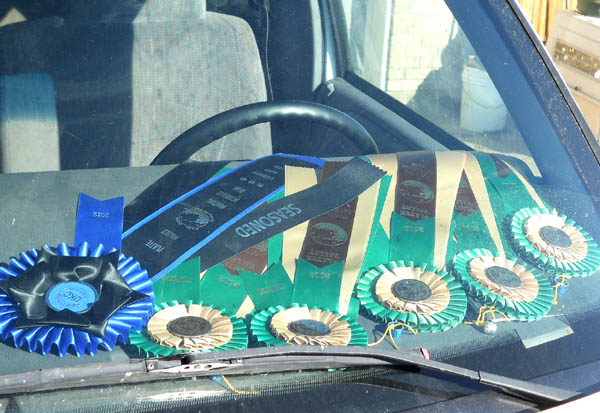
Ready to do it again?
I hope so!
Take stock of how you and your dog did and what weaknesses you should work on. Make a plan for how you can do better next time.
Other organizations
There are other retriever competitive associations:
This post was originally published on January 24, 2022. Edited and updated with new content on July 12, 2024.
Header image by Linda Alexander.
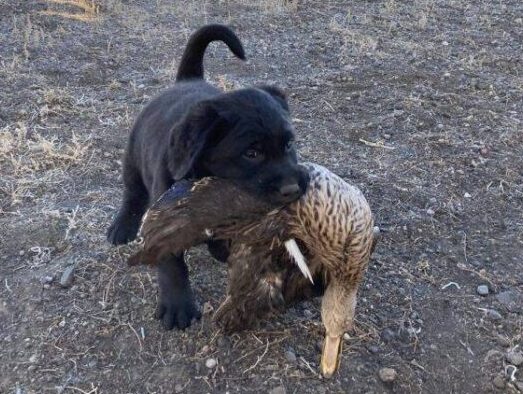
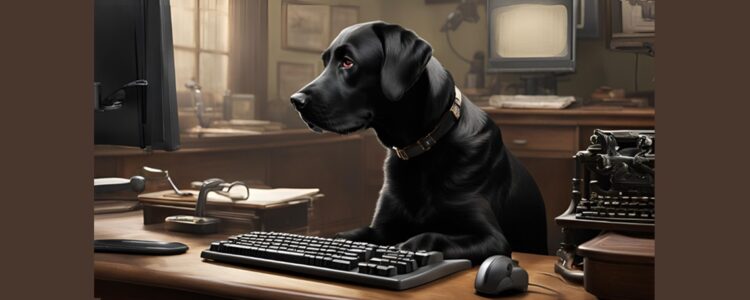
Browse this list of helpful links for Labrador Retrievers – clubs, competition, health issues, and more.
To request a link to a Lab club website or other helpful link or to update an existing link, please contact us.
National & International Dog Clubs
American Kennel Club (AKC)
Canadian Kennel Club (CKC)
Federation Cynologique Internationale (FCI)
The Labrador Retriever Club Inc
Master Amateur Retriever Club (MARC)
Master National Retriever Club (MNRC)
North American Hunting Retriever Association
Dog show info
List of AKC Licensed Dog Show Superintendents
Hunt test and Field trial entries
Health
American College of Veterinary Ophthalmologists (ACVO)
American Veterinary Medical Association
ASPCA Animal Poison Control Center, 24-Hour Emergency Number
888-426-4435
Animal Health Diagnostic Center
Genetic & Health Testing
US Labrador clubs
Dallas-Fort Worth Labrador Retriever Club
Greater Atlanta Labrador Retriever Club
Heart of Texas Labrador Retriever Club
Huron River Labrador Retriever Club
Labrador Retriever Club of Greater Denver
Labrador Retriever Club of the Pioneer Valley
Labrador Retriever Club of Southern California
Labrador Retriever Club of the Potomac
Mid-Jersey Labrador Retriever Club
Puget Sound Labrador Retriever Association
San Diego Labrador Retriever Club
Spirit of St. Louis Labrador Retriever Club
Winnebago Labrador Retriever Club
Lab links
Coat Color Inheritance in the Labrador Retriever
Other
Dog Lovers Bookshop (hard to find used, out of print and rare books)
Therapy Dogs International, Inc. (TDI)
Header image AI generated via Canva
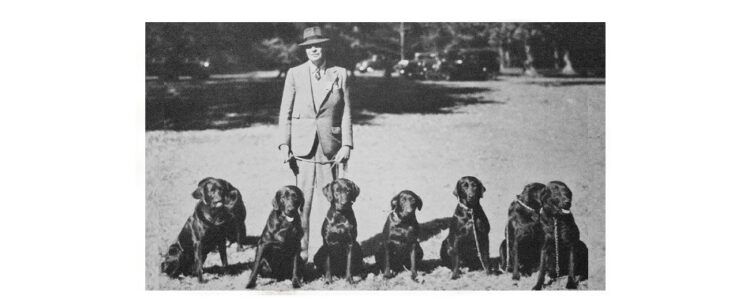
Jay Carlisle (and his Wingan Kennel) was “…undoubtedly the one to whom most credit is due for the rise in the popularity of Labradors in the U.S.A.”
– Labrador Retriever Club Yearbook, 1931-1944
Imagine, if you will, the sprawling mansions, huge parties, and nouveau riche of The Great Gatsby era. The Great War had ended, Prohibition brought speakeasies and organized crime, and the stock market crashed. It is in such a setting we find Jay Carlisle and his Wingan Kennel.
Born in Brooklyn in 1868, Carlisle was a stockbroker and the Governor of the American Stock Exchange during the 1929 crash. His wife was Mary “May” Pinkerton Carlisle. (Yes, that Pinkerton family.)
Carlisle was also a sportsman. His horses ran on the track or competed in shows. He rode to hounds and played polo. And he fished and hunted.
We pick up his story when Carlisle turned his attention to Labrador Retrievers.

Image courtesy East Islip Historical Society – www.eastislip.org
Step 1 – Import the Best Labradors
Jay Carlisle liked a good-looking dog, but he wanted more. He wanted dogs with an acceptable show record and qualified in the field. “Once Mr. Carlisle had decided that the Labrador was to be his breed, he began a study of existing blood lines. He went over countless records, and all the time he had in mind the qualities that he wanted.” 1
After breeding, raising, showing, and racing horses, he developed a discerning eye. However, in the early 1930s, the Lab was still new to America and field trials were just getting started. Carlisle promised to make the breed as popular in America as it was in Britain.
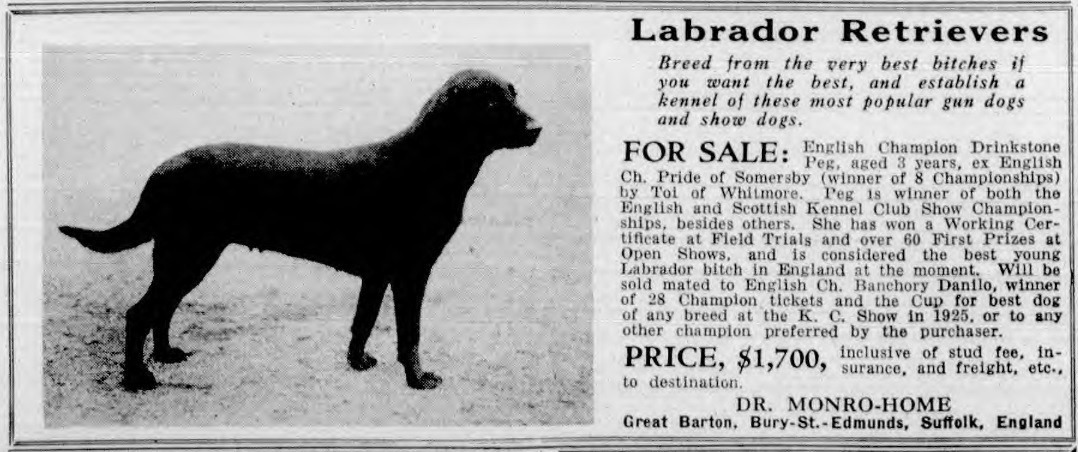
Peg was offered for sale for $1700. Today’s equivalent is about $30,000.
After researching, he imported nine of the finest Labs to start his kennel. The best of these was English Champion Drinkstone Peg of Wingan. She was born in 1927 and bred by Dr GH Monro-Home of Scotland.
Of the other eight Labs, three came from Lorna, Countess Howe.
Eng Am CH Drinkstone Peg of Wingan
Peg was sensational in the show ring and earned nine Challenge Certificates which are similar to ‘winning the points’ in America. Three certificates were enough for a championship, but she kept on winning.
In England there is a ‘show championship’ and a ‘full championship’. A full championship requires the dog to prove it can work in the field as well as win in the show ring. Peg earned her working certificate at the International Gun Dog League retriever trails in 1930 and became a full champion.
She also won her show championship in America. But despite being a top show dog, Carlisle was more interested in Peg’s potential for breeding. Of course the male is also important so he had her bred to Dual Champion Bramshaw Bob. He was one of England’s greatest show dogs and stud dogs.
Two months later Peg whelped seven puppies at Carlisle’s Wingan kennels.
After raising her puppies, she went back into the show ring and continued winning. One of her big wins was Reserve at the Westminster Kennel Club show in 1934.
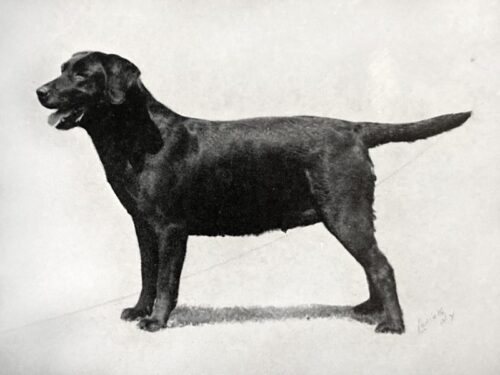
| Eng Am CH Drinkstone Peg of Wingan black female, born 4/18/1927 |
Toi of Whitmore FTW | Tyg of Whitmore |
| Bute of Trentham | ||
| Eng CH Pride of Somersby | Brayton Siddy | |
| Juno of Somersby FTW |
CH Drinkstone Pons
Another dog Carlisle imported was Drinkstone Pons. He was Peg’s son sired by English Champion Banchory Danilo and bred by Dr Monro-Home.
Pons started his show career as a puppy. He won many prizes and was often chosen as the best Labrador, best retriever and/or best gun dog. Pons won Best of Breed at the Westminster Kennel Club show – twice – and also won second in the group competition. He won Best in Specialty Show at the annual Labrador Retriever Club Inc. show.
In 1934 he started running and placing in field trials. He won the Open novice stake the the Brookhaven Game Protective Association trial with kennel mates Night Light and Ben taking second and third. A New York Times reporter said “The placed dogs showed the influence of the highest breeding, combined with thorough training. All the Wingan representatives exhibited intelligence in their hunting, with a minimum of direction from their handler.” 2

| CH Drinkstone Pons of Wingan black male, born 5/11/1931 |
Eng Ch Banchory Danilo FTW | Eng Dual Ch Banchory Bolo |
| Munden Scarcity | ||
| Eng Am Ch Drinkstone Peg of Wingan | Toi of Whitmore FTW | |
| Eng Ch Pride of Somersby |
Drinkstone Mars
Mars was another outstanding dog. He often won in the show ring and earned his certificate of merit under judges Countess Howe and the Honourable Mrs. Hill Wood.
Pons and Mars were littermates and won the brace class together. Mars won the points toward his show championship at the Labrador Retriever Club Inc. specialty show in 1934. And as a dual purpose Labrador, he also won in field trials.

| Drinkstone Mars of Wingan black male, born 5/11/1931 |
Eng Ch Banchory Danilo FTW | Eng Dual Ch Banchory Bolo |
| Munden Scarcity | ||
| Eng Am Ch Drinkstone Peg of Wingan | Toi of Whitmore FTW | |
| Eng Ch Pride of Somersby |
CH Liddly Bulfinch of Wingan
Bulfinch was another import and was bred by H.A. Richardson. He won about 50 times at championship shows and certificates of merit at field trials.
And he won the points at the Labrador Retriever Club Inc. annual specialty show in 1935. This means he defeated the other non-champion males and earned points toward his show championship.
Bulfinch completed his championship with a 4-point win at the Long Island Kennel Club show in May 1936.
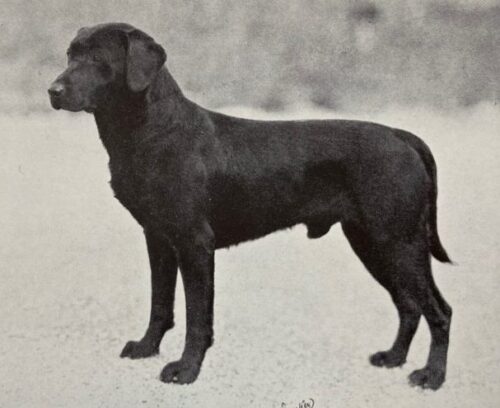
| CH Liddly Bulfinch of Wingan black male, born 2/7/1932 |
Eng CH Tar of Hamyax | Toi of Whitmore FTW |
| Sunshine of Fasham | ||
| Delyn of Liphook | Eng CH Banchory Danilo FTW | |
| Ridgeland Black Diamond |
FC Banchory Night Light & CH Banchory Jetsam
Banchory Night Light and Banchory Jetsam were littermates sired by Blackworth Midnight. They were bred by Miss L. Croad of England.
In 1935 Field and Stream Magazine began offering a challenge trophy to the dog that earned the greatest number of points. Only competition in Open All Age Stakes counted.
Night Light was one of the top Labradors and earned 12 points in the contest. Banchory Varnish of Wingan earned 10 points and Glenairlie Rover was tied with Blind of Arden at eight points.
He was a Field Champion and major pointed in dog shows. Jetsam was a Show Champion which included winning the points at the Westminster Kennel Club show in 1934.
Tops of Bigstone, Night Light’s daughter, produced several quality dogs. These included Dual CH AFC Matchmaker for Deer Creek, FC AFC Ladies Day at Deer Creek, and Kingdale’s Ink Spot.
It’s interesting that Night Light carried the chocolate gene while his sister, Jetsam, carried the yellow gene.
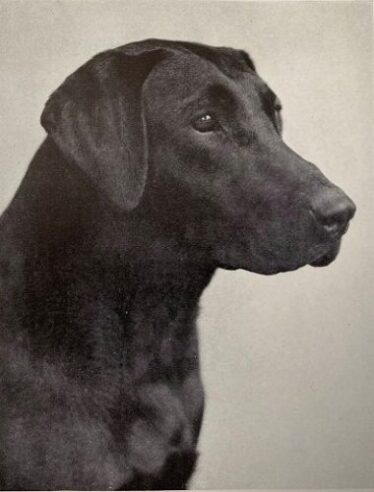
FC Banchory Night Light of Wingan

CH Banchory Jetsam
| FC Banchory Night Light of Wingan black male, born 1/1/1932 CH Banchory Jetsam black female, born 1/1/1932 |
Blackworth Midnight | Eng CH Wilworth Rip |
| Brookstone Jet CCW | ||
| Dinah of Wongalee | Eng CH Beningbrough Tangle FTW | |
| Wendy of Wongalee |
Banchory Dapper
Banchory Dapper was a half brother of Night Light and Jetsam, all sired by Blackworth Midnight. He won a 5-point major at the Labrador Retriever Club Inc. specialty show in 1934.
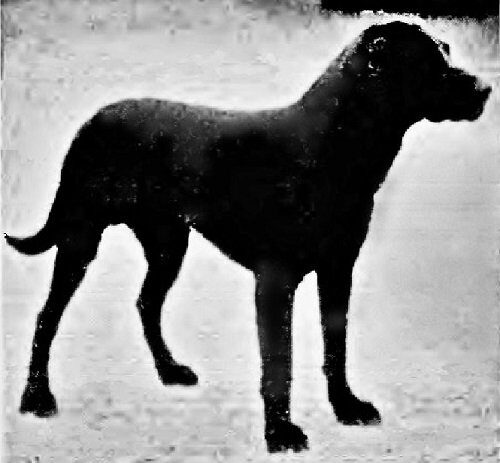
| Banchory Dapper black male, born March 1932 |
Blackworth Midnight | Eng CH Wilworth Rip |
| Brookstone Jet CCW | ||
| Banchory Student | Eng CH Banchory Danilo | |
| Eng CH Pride of Somersby |
Orchardton Doris of Wingan
Orchardton Doris was bred by S.H. Carruthers and worked as a field dog in Scotland.
After coming to America she was described as “a high class bitch with beautiful style, great pace and very keen… She and her handler, Dave Elliot, gave a beautiful exhibition of giving and taking direction to an unmarked fall by hand and whistle, without undue disturbance of ground on either side. She has an invariably excellent pick-up, carry and delivery.” 3
A fast and expert retriever, Doris also had several wins in the show ring.
She was the mother of Pons Junior of Wingan and Wingan’s Daily Double and the grandmother of FC Timber Town Clansman.

| Orchardton Doris of Wingan FTW black female, born 12/31/1930 |
Eng Ch Ingleston Ben | Duke of Kirkmahoe FTW |
| Ingleston Nancy FTW | ||
| Orchardton Dawn | Eng CH Brocklehirst Donner | |
| Hardies Choice |
Eng Sh CH Am CH Banchory Trump of Wingan
The ninth dog, Banchory Trump, stayed in England until he finished his show championship. After coming here, he finished his American show championship with Best of Breed wins at the Westminster Kennel Club dog show and at the Labrador Retriever Club Inc. specialty.
He won numerous Bests of Breed awards and placed in the group several times.
His Best of Breed winning streak included several very competitive shows:
- Morris & Essex, 5/23/1936
- The Labrador Retriever Club Inc, 6/27/1936 – Best In Specialty Show
- Morris & Essex, 5/29/1937
- The Labrador Retriever Club Inc, 6/18/1937 – Best In Specialty Show
- Westminster Kennel Club, 2/10-12/1938
- International Kennel Club, 4/2-3/1938
- Leavenworth Kennel Club, 4/27-28/1938 – Best Of Breed and Group 3rd
- Des Moines Kennel Club, 11/12-13/1938 – Best Of Breed and Group 4th
Trump sired females that passed on excellent genetics. Bred to CH Bancstone Lorna of Wingan he produced Huron’s Lady, the mother of Dual CH Grangemead Precocious. When he was bred to a daughter of Eng FTCh Banchory Varnish of Wingan he produced Peggy of Pheasant Lawn. Peggy was the mother of FC Pickpocket for Deer Creek and Bancstone Dinah, grandmother of NFC AFC Massie’s Sassy Boots.
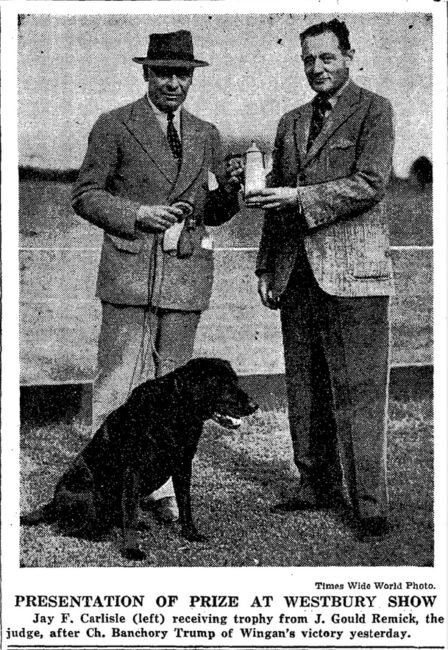
| Eng Sh CH Am CH Banchory Trump of Wingan black male, born 8/21/1931 |
Blenheim Scamp FTW | Balwearie |
| Blenheim Lady | ||
| Lady Daphne | Saffrons Bob CCW | |
| Haste |
Drinkstone Peg’s British litter
Below are Peg’s puppies by Eng Dual Ch Bramshaw Bob.
| Litter bred in England and born in America Born 8/7/1933 |
Eng Dual Ch Bramshaw Bob | Eng Ch Ingleston Ben |
| Eng FTW Bramshaw Brimble | ||
| Eng Am Ch Drinkstone Peg | Eng FTW Toi of Whitmore | |
| Eng Ch Pride of Somersby |
CH Bancstone Ben of Wingan
Owned by J.F. Carlisle
Ben placed in field trials and also did very well in shows. He finished his show championship with multiple five-point majors.
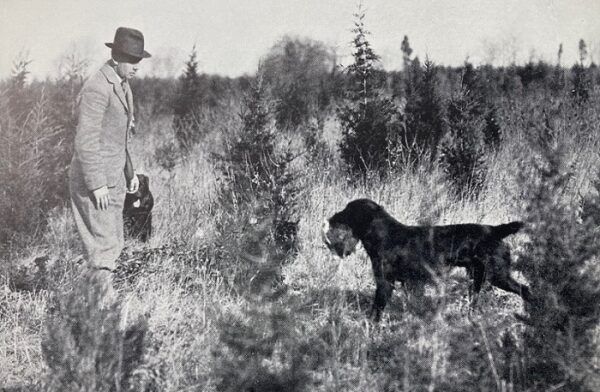
Bancstone Blair of Wingan
Owned by J.F. Carlisle
Although he wasn’t shown much he almost always won his class and even won Best of Breed.
CH Bancstone Bob of Wingan
Owned by J.W. Redmond
Bob also finished his show championship with three five-point majors – including at the Westminster Kennel Club dog show in 1937.
Bancstone Doctor of Wingan
Owned by J.F. Carlisle
Although Doctor was also shown, he didn’t finish his championship.
CH Bancstone Countess of Wingan
Owned by J.F. Carlisle
Countess won Reserve Winners Bitch at both the Westminster Kennel Club dog show and the Labrador Retriever Club specialty show. She finished her championship title with two 5-point and two 4-point major wins.

CH Bancstone Lorna of Wingan
Owned by J.F. Carlisle, later by James R McManus
Another Wingan-bred show dog that finished her championship with three 5-point majors. And she won Best in Specialty Show at the Labrador Retriever Club specialty show in 1935.
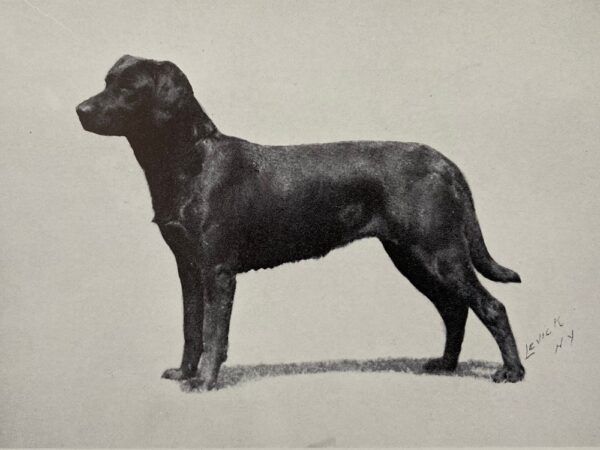
Bancstone Peggy of Wingan
Owned by J.F. Carlisle, later by C.H. Mackay
Although she was halfway to her show championship, it appears she never finished her title.
Other Labs
Carlisle had many dogs – some he bought and some he bred. Here are a few of his better known Labs.
Eng FTCh FC Banchory Varnish of Wingan
Owned by J.F. Carlisle, later by Mrs. Kathleen B. Starr (Timber Town)
In April 1937 Varnish won the Open all-age stake at the Long Island Retriever Field Trial Club. He was described as “consistent in his work throughout a long day … in which champions and top field-trial dogs fell by the wayside.” He “did all that was asked of him in his work on land, quartering, taking direction, showing intelligence in his questing and exhibiting nose for his game.” 4
He also won the Open stake at the Brookhaven Game Protective Association trial in the fall of 1937. “In the second series, his first bird was easy; but the second was dropped across the road in back of motor cars and gallery. The dog worked out the problem, however, and retrieved the bird in grand shape. In the third series, his speed and precision could not possibly escape the notice of the judges while his marking was exceptional.” 5
The gallery cheered their old-time favorite.
Varnish was also pointed in the show ring.

| Eng FTCh FC Banchory Varnish of Wingan black male, born May 1933 |
Eng Dual Ch Banchory Painter | Eng Ch. Peter the Painter |
| Glenhead Bess | ||
| Hawkesworth Glimmer | Banchory Tealer | |
| Bramshaw Gloss |
Pons Junior of Wingan
Pons Junior won the Brookhaven amateur trial handled by Mrs. Kathleen B. Starr (Timber Town kennels). He was described as making “two grand retrieves in the water test, going out on a surveyor’s line to both ducks.” The stake was judged by Colonel the Lord Vivian, D.S.O., of Britain, and David Wagstaff of Tuxedo Park, NY. 6
He also did well in the show ring including winning Reserve Winners Dog at the Westminster Kennel Club dog show in 1937.
A year later Timber Town Clansman, his two-year-old son, won the Women’s Field Trial Club non-winners stake.
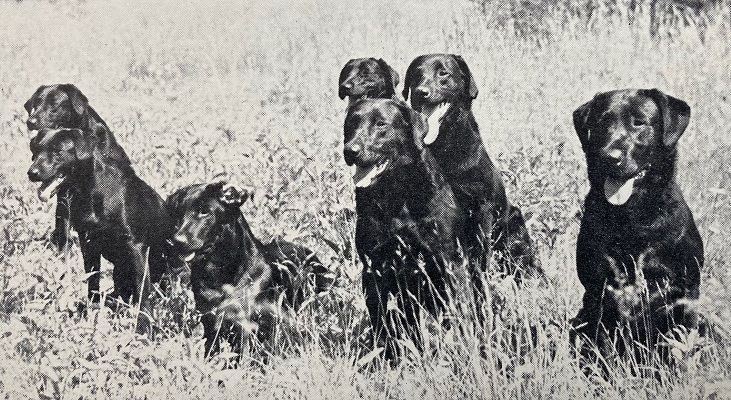
Rear, left to right: Pons Junior, Ebony of Barrington, Banchory Night Light, CH Drinkstone Pons. Front: Whitecairn Wendy, Banchory Varnish, CH Bancstone Ben.
| Pons Junior of Wingan black male, born 4/30/1934 |
Drinkstone Pons of Wingan | Eng FTCh Banchory Danilo |
| Drinkstone Peggy | ||
| Eng FTW Orchardton Doris of Wingan | Eng Ch Ingleston Ben | |
| Eng FTW Orchardton Dawn |
Okanagan Sandy
Sandy was bred in Canada and was special enough to earn a place at Wingan Kennels. One of the field trials he ran was under particularly difficult conditions.
“Six dogs were called back for the final elimination with the sea pounding on the outer bars, whitecaps making in the inlet and snow squalls driving inland. Dog after dog was sent into the icy water. Suddenly the black clouds closed down and the whole world was shut out by a driving snowstorm….
“Sandy’s water work was little short of perfection, he taking to the water with a huge splash, after having marked his two falls…” 7
| Okanagan Sandy black male, born 4/5/1934 Bred by R. Leckie Ewing, Canada |
Beaver of Bryn | Banchory Jock |
| Munden Stigma | ||
| Gay’s Vesta | Eng Nat’l FTCh Beningbrough Tanco | |
| Eng FTCh Vidi of Adderley |
Okanagan Tanco
Tanco was another import from Canada. In November 1936, he won the Derby stake at the Labrador Retriever Club trial in Peapack, NJ.
As the winner, he brought home the directors’ trophy and $25. Although that doesn’t sound like much it’s the equivalent of over $500 today.

| Okanagan Tanco black male, born 6/17/1935 |
Okanagan Rusty | Beaver of Bryn |
| Okanagan Gyp | ||
| Gay’s Vesta | Eng Nat’l FTCh Beningbrough Tanco | |
| Eng FTCh Vidi of Adderley |
Orchardton Duce of Wingan
Owned by Jay Carlisle, later by Mrs Eleanor F. Remick
Duce won the Labrador Retriever Club’s Derby stake at 14 months old. Colonel the Lord Vivian, D.S.O., of Cornwall, England judged together with Dr. Samuel Milbank and Francis Squires. The trial was held at Shinnecock Hills in Nov 1937.
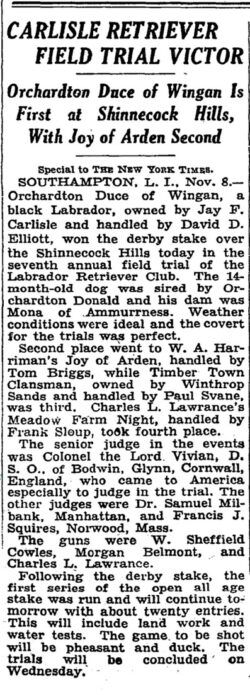
| Orchardton Duce of Wingan black male, born approximately Sep 1936 |
Eng Ch Orchardton Donald | Eng Ch Ingleston Ben |
| Orchardton Dawn | ||
| Mona Of Ammurrness | Eng FTCh Tag of Clava | |
| Queen of the May |
Whitecarin Wendy of Wingan
Owned by Jay Carlisle
Wendy won the Open stake at the Brookhaven Game Protective Association field trail in 1935. The weather was described as “almost ideal, the thermometer hovering around the freezing mark, and the wind was just strong enough to make it a sporting proposition for guns and dogs.” 8

| Whitecarin Wendy of Wingan black female, born approximately 1933 |
Ranger of Kentford | Gift of Halleaths |
| Kirkbean Gyp | ||
| Lochar Kate FTW | Eng Dual Ch Banchory Bolo | |
| Murrayfield Bet |
Wingan’s Daily Double
Another Wingan dog deserving of mention is Daily Double. Bred by Carlisle and sold to Howes Burton, an amateur, who handled her himself. She won at the Long Island Retriever Field Trial Club in 1939 and placed second in what was called “fast company” just a week before. The winner in that trial was Earlsmoor Moor of Arden.
However what makes her special is the combination of pedigree and offspring. She was a half-sister to Blind and Decoy of Arden on her father’s side. And a half-sister to Pons Junior on her mother’s side.
When bred to Eng FTCh Glenairlie Rover, she produced Mint of Barrington who in turn sired NFC AFC Marvadel Black Gum “Blackie”.
Blackie was High Point Derby dog in 1946. He won his first Open stake at 16 months of age and finished his field championship the next year. And he qualified for eight consecutive National Opens (1946-1953), winning in 1949.
| Wingan’s Daily Double black female, born 7/9/1936 |
Odds On FTW | The Favorite FTW |
| Jest | ||
| Orchardton Doris of Wingan FTW | Eng CH Ingleston Ben | |
| Orchardton Dawn FTW |
Step 2 – Build the Best Kennels
Instead of a heated kennel building with attached runs, Jay Carlisle built condos for his Labs. He felt it would be hard for the dogs to go from a heated kennel to retrieving in icy water.
Each condo was 6×11 feet, made out of redwood and set on 4x4s to avoid rot. Inside were two rooms – a 5×6 foot vestibule that became a shaded porch in summer and a 6×6 foot sleeping compartment with a hallway to avoid drafts.
They even had lights, windows and a hinged roof for cleaning.
The condos were set in 20×30 foot concrete runs with trees for shade. Puppies had a similar set up in a larger grass run.

Nearby was the feed house where they stored supplies and prepared meals for the dogs. Puppies were fed five meals a day – cereal with milk in the morning, cooked beef, raw beef, milk and biscuit and a big-dog meal.
Adult dogs got cooked meat twice a week with commercial food, cod liver oil and yeast. Occasionally they got salmon or raw beef.
Step 3 – Import the Best Help
While Jay Carlisle was looking for the best Labs, he was also looking for someone to train the dogs. For that he looked to Scotland where many men learned the business as kennel men and game raisers.
With the help of Countess Howe and many others, Carlisle found the right man. In 1934 he brought David D. Elliot to Long Island from Scotland.

A few months later at the Brookhaven Game Protective Association trial they swept all three places in the open novice stake. Drinkstone Pons of Wingan won $50 for first place. That’s over $1000 in today’s currency. Second place and $30 to Banchory Night Light of Wingan. Third place and $20 to Bancstone Ben of Wingan.
Carlisle did indeed find the right man to run his kennel.
David D. Elliot
Elliot grew up near Edinburgh, Scotland, where he learned about sheepdog trials from his grandfather. Watching how the sheepdogs responded to signals gave him the idea to teach signals to Labs. A form of these signals is still used today to guide dogs on blind retrieves.
Lady Howe, Dr. Monro-Holm and David Black (breeder of Peter of Faskally) recommended Elliot as a kennelman for Carlisle. Elliot agreed to come for five years, but instead, he stayed for a lifetime.
In addition to training dogs, he also trained people. They included Dorothy Howe (Rupert), Joan Redmond (later Joan Reed, Chidley) and Kathleen Starr (later Mrs Fredricks, Timber Town). The ladies were sometimes called “Elliot’s Harem.” Cotton Pershall was another person who learned how to handle dogs at Wingan.
Carlisle was pleased with Elliot’s training and thanked him for introducing him to field trialing. The competition made him happy despite the recent death of his wife.
If you’d like to see Elliot and two of his retrievers – Eng FTCh FC Banchory Varnish of Wingan and FC Timber Town Clansman – check out the “Sky Game” video, filmed in 1939.
Step 4 – Promote the Kennel and Competition
Jay Carlisle registered Wingan as his kennel name in 1933.
He ran ads in a variety of magazines – from the AKC Gazette to Vanity Fair.

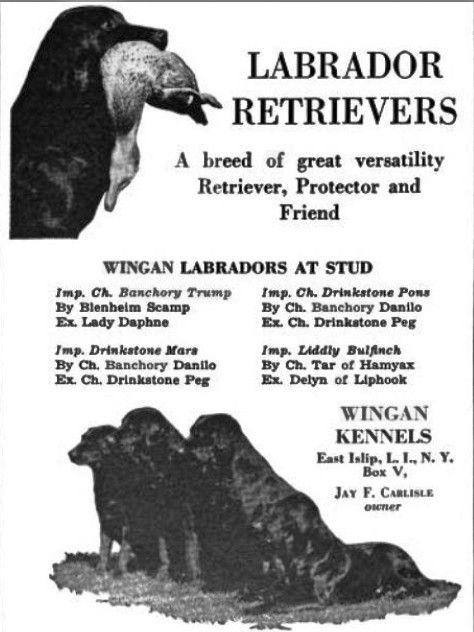

He served as President of the Labrador Retriever Club from 1935-1938. During that time he established the Amateur stake and donated a perpetual trophy so the stake would continue.
Carlisle, Anthony Bliss, Franklin Lord, Gould Remick, Henry Root Stern, and Leonard Buck formed the Long Island Retriever Trial Association. The club’s purpose was to encourage the breeding, training, and use of retrievers, and for holding of all-breed retriever trials.
David Elliot wrote a book about Labs and training them and Carlisle published it in 1936. It included training advice and many photos of Wingan Labradors.
“The efforts and absorbing interest of J. F. Carlisle, his participation in trials and at shows, and his generous offering of dogs at stud to new breeders gave the breed a tremendous push forward in this period. He helped to form a nucleus of good material to build upon, together with the superb group of imports… All this gave the breed the right start, and it was not long before history repeated itself, so that the Labrador was on its way to overtaking all the other Retriever varieties in the New World, as it had in the Old.” 9
The End and a Beginning
Jay Carlisle died in 1937, just eight months after his wife.
He was so respected, that 28 prominent men volunteered to act as pallbearers. A special train transported guests from Penn Station in New York City to Carlisle’s home in East Islip, Long Island.
The retriever community postponed a field trial so contestants could attend his funeral. However the postponement meant the trial had to be limited in order to finish in one day. This was the start of Limited All-Age stakes.
The Labrador Retriever Club, Inc. set up a Jay Carlisle Memorial Trial. It was held from 1938 to 1941 near his home on Long Island. Mrs. Hill-Wood, Morgan Belmont and Robert Morgan judged the first Memorial Trail.
On a sad note, the contents of his home went to auction in 1938 and his beautiful mansion was demolished in 1940.
Most of his dogs were given to the young Scotsman, David D. Elliot. He also received the specially-modified green and yellow dog wagon and the right to rent the Wingan kennel at a reduced rate.
Although it seems like a sad ending, the dogs did continue competing with Elliot. And many people recognized Carlisle’s contribution to Labradors and to field trials in America.
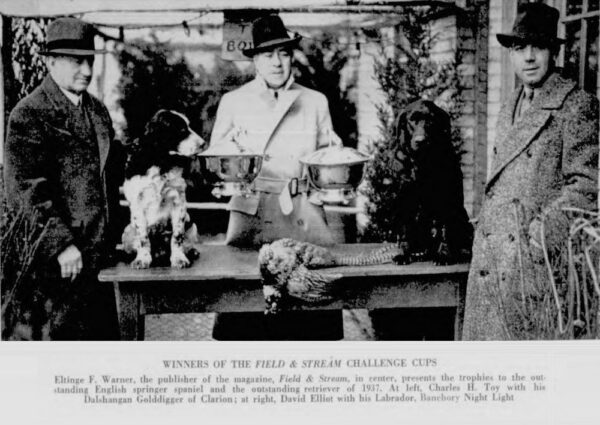
David Elliot (right) with Banchory Night Light winning the Field & Stream Challenge Cup for Outstanding Retriever of 1937.
Today
Few people recognize the Wingan name today or they confuse it with Helen Ginnel’s Whygin kennel. But Carlisle’s efforts – importing quality dogs, making his stud dogs available, and promoting Labradors – helped make the breed as popular in America as it was in England.
I’m proud to have several dogs that trace back to the Wingan Labradors.
— Chip and his descendants trace to –
* NFC Banchory Night Light of Wingan (grandsire of Dual CH Matchmaker for Deer Creek)
* Am Eng CH Banchory Trump of Wingan (grandsire of Dual CH Grangemead Precocious and FC Pickpocket for Deer Creek)
* CH Bancstone Lorna of Wingan (granddam of Dual CH Grangemead Precocious)
* Penney of Wingan (dam of NFC AFC Massie’s Sassy Boots)
— Dee and her descendants trace to –
* CH Banchory Jetsam
* NFC Banchory Night Light of Wingan (grandsire of Dual CH Matchmaker for Deer Creek)
* Am Eng CH Banchory Trump of Wingan (grandsire of Dual CH Grangemead Precocious and FC Pickpocket for Deer Creek)
* Eng FTCh FC Banchory Varnish of Wingan
* CH Bancstone Lorna of Wingan (granddam of Dual CH Grangemead Precocious)
* Bancstone Blair of Wingan (grandsire of NFC NAFC CFC Major VI, 1993 Hall of Fame)
* CH Bancstone Peggy of Wingan
* Eng Am CH Drinkstone Peg (dam of the Bancstone litter by Eng Dual CH Bramshaw Bob)
* Orchardton Doris of Wingan (dam of Pons Junior Of Wingan and Wingan’s Daily Double)
* Pons Junior of Wingan (sire of FC Timber Town Clansman and great grandsire of NFC Dual CH CFC Bracken’s Sweep)
* Wingan’s Daily Double (granddam of NFC AFC Marvadel Black Gum)
Notes:
[1] Arthur Frederick Jones, “True Labradors and Traditions Live at Wingan,” American Kennel Gazette, February 1934
[2] Henry R. Ilsley, “Carlisle’s Entries Take All Three Places in Open Novice Retriever Stake,” New York Times, December 29, 1934
[3] Helen Warwick, “The Complete Labrador Retriever” (New York: Howell Book House, 1965), 137
[4] Staff correspondent, “Carlisle’s Labrador Beats 22 Dogs in Long Island Retriever Clubs Trial,” New York Times, April 18, 1937
[5] Ned Corey, “Banchory Varnish of Wingan First in Brookhaven All-Age,” American Kennel Gazette, December 1, 1937, 94
[6] Staff correspondent, “Brookhaven Field Trials Are Marked by Splendid Work and Keen Competition,” New York Times, October 31, 1937
[7] Henry R. Ilsley, “Retriever Laurels Annexed by Carlisle’s Dog at Trials Held in Snowstorm,” New York Times, November 29, 1936
[8] A.F.J., “Whitecairn Wendy of Wingan Wins Brookhaven’s Open Stake,” American Kennel Gazette, January 1, 1936, 168
[9] Warwick, “The Complete Labrador Retriever,” 126
Glossary:
- AFC – Amateur Field Champion
- Best of Breed – At a dog show, the dog that has defeated all the other dogs of its breed.
- Best of Opposite Sex – If a male dog wins Best of Breed, the best female wins Best of Opposite Sex, and vice versa.
- BLF / BLM – Black Labrador female or black Labrador male
- Brace class – Two dogs shown together that look very much alike.
- CCW – British Challenge Certificate winner (show win, but not a title).
- CH – Dog show championship
- Dual Champion – A dog that has won a show championship AND a field championship.
- English show champion (“Eng Sh CH”) – A dog that earned a show championship, but lacks the working certificate to be a full champion.
- FC – Field Champion (British FTCh) – A dog that has won enough in field trials to qualify for the field champion title.
- FTW – Field trial winner (not a title)
- Full champion – England requires Labradors to pass a working test in addition to earning a show championship.
- Major points – In the US, Winners Dog and Winners Bitch can each receive points based on the number of dogs defeated. It can be 0-5 points, with 3 to 5 point wins called “majors.”
- NFC – National Field Champion
- QAA or *** – A dog that has proved himself in the Qualifying stake and could enter the limited Open or Amateur stakes.
- Reserve Winners – The second best dog of its sex that has not completed a show championship.
- Winners (also Winners Dog or Winners Bitch) – In the show ring, males (“dogs”) compete against other males in various classes. Then the winner of each class competes against the other winning males for Winners Dog. Depending on the number of males defeated, the Winners Dog will receive up to 5 points towards his show championship. It works the same for females.
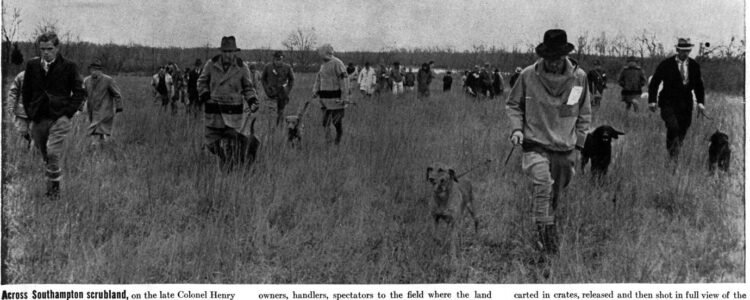
The first championship stake was held in Southampton, Long Island on November 20-21, 1938. Blind of Arden was one of twenty-two of the best retrievers in the US came to compete. They retrieved pheasants shot in the field and ducks shot over water. The dogs saw some birds shot while other birds were planted out of sight. Dogs had to be guided by their handlers to find these birds.
In the header image, you can see the judges, owners, handlers, spectators and dogs trudging across the field trial grounds. 1
The Winner
One dog, FC Blind of Arden did the work without a mistake. He clinched the win with the final blind retrieve described as follows:
“…a dead duck, unseen by the dogs, was planted on an island. At a signal from his handler, Blind jumped into the water and swam to the island. There he scented the bird, looked back only twice to the handler, who with his arm waved him in the right direction. Quickly finding the duck, Blind picked it up with a firm mouth, started swimming back to his handler.” 2
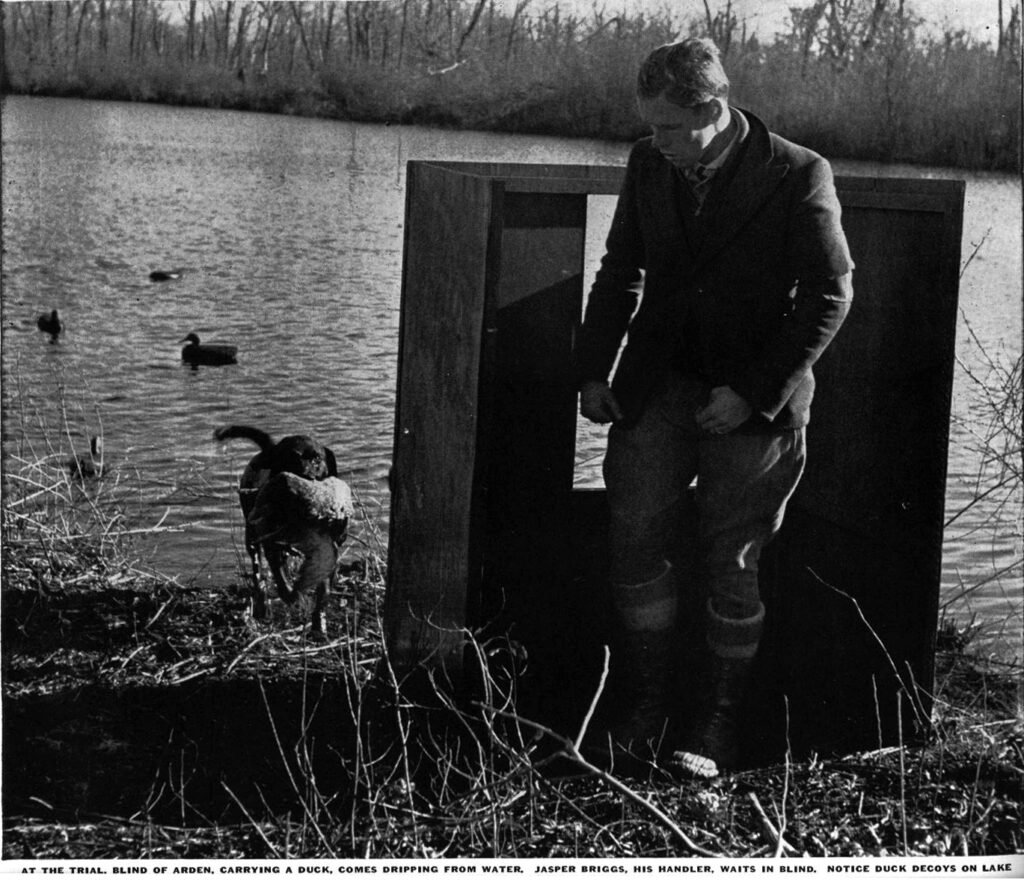
Blind retrieving a duck to his handler, Jasper Briggs.
Life Magazine featured Blind on the magazine’s cover on December 12, 1938. This was the first time a dog had ever been on the magazine’s cover.
US Field Trials
The Labrador Retriever breed was just getting started in the United States and had only been officially recognized by the America Kennel Club five years earlier.
The first retriever field trial was held in 1931. In 1935, Field and Stream Magazine provided a perpetual trophy that would be awarded each year to the dog that earned the most points in Open All-Age stakes. Blind of Arden won it the first year and his half-sister, FC Tar of Arden, won it a few years later. It was 1941 before the National Retriever Field Trial Club was formed.
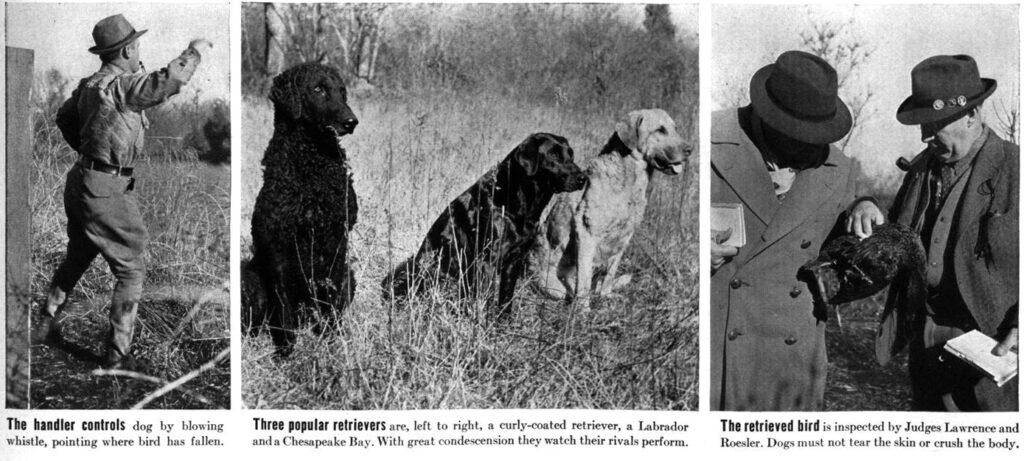
(left) A handler controls the dog using whistle and arm signals.
(center) Three retriever breeds – a Curly coated retriever, a Labrador and a Chesapeake Bay retriever.
(right) Judges inspect a retrieved bird. Dogs must hold them firmly, but gently so as not to break the skin or crush the bird. After the trial, the birds are sold.
At that time, retriever trials were the realm of the very rich. Owners imported dogs from England, enticed dog trainers from Scotland and set up amazing hunting estates on the east coast. To have a chance of winning the Field and Stream trophy, dogs had to run in many trials throughout the East and Mid West.
Blind’s owner was W. Averell Harriman of New York. He was the son of a railroad baron and, in his own career, he served as Secretary of Commerce under President Truman, served as a diplomat in relations with the Soviet Union during World War II and later served as governor of New York.

Blind of Arden training with a live pheasant.
Blind of Arden’s Pedigree
| Odds On FTW | The Favorite FTW | The Limit |
| Cache Of The Rhins FTW | ||
| Jest | Mansel’s Timothy | |
| Bess | ||
| Peggy of Shipton FTW | Ronald of Candahar | Eng FTCh Rag Tag |
| June | ||
| Gehta of Sigeforda | Eng FTCh Banchory Bluff | |
| Eng CH Balbeardie FTW |
Although Blind didn’t seem to produce any titled dogs himself, he did pass on his genetics to future generations. Some dogs that descend from him include:
- CNFC FC AFC Ardyn’s Ace of Merwalfin
- Eng FTCh Eng AFTCh Slo-Poke Smokey Of Dairy Hill
- FC AFC Jet of Zenith
- CNFC FC Rip of Holly Hill
Blind’s great great grandson
Jet of Zenith’s pedigree is interesting.
| NFC AFC Massie’s Sassy Boots Hall of Fame |
Shadow II | Black Spook of Riverside |
| Dark Lady | ||
| Penney of Wingan | Darky of Wingan | |
| Bancstone Dinah | ||
| Thornwood Rhea | CNFC FC Rip of Holly Hill | Skip of Timber Town |
| Okanagan Molly (by Varnish’s Tuff, out of Marjay of Wingan, by Blind of Arden) | ||
| Graysmarsh Christmas | 3xNFC CFC Dual CH Shed of Arden | |
| Graysmarsh Middy (by Blind of Arden) |
Starting at the bottom of the pedigree, Blind’s daughter, Graysmarsh Middy, was bred to her cousin, 3xNFC CFC DUAL CH Shed of Arden, thus doubling up on Peggy of Shipton.
A female from that litter, Graysmarsh Christmas, was bred to CNFC FC Rip of Holly Hill. Rip was a great great grandson of Blind through Okanagan Molly, thus doubling up on Blind.
A female from the Rip x Christmas litter, Thornwood Rhea, was bred to NFC AFC Massie’s Sassy Boots. Boot’s mother, Penney of Wingan, had several lines back to Eng DUAL CH Banchory Bolo and other dogs owned or bred by Lorna, Countess Howe.
Read more about the Wingan Labradors.
Blind’s sisters
Then there was Blind’s full sister – FC Decoy of Arden – who was an outstanding producer. She was the mother of:
- 3xNFC CFC DUAL CH Shed of Arden,
- DUAL CH Braes of Arden,
- DUAL CH Gorse of Arden,
- CH Earlsmoor Moor of Arden,
- CH Earlsmoor Marlin of Arden (all by CH Raffles of Earlsmoor) and
- FC Gun of Arden (by Toff of Hamyax FTW)
And Blind’s half-sister – NFC Tar of Arden (by Hiwood Risk) – who was the mother of Dual CH CFC Little Pierre Of Deer Creek.
(Click for help understanding the various titles dogs have earned)
Arden Labradors
Blind was bred and owned by Mr. Harriman.
“According to Bob Bartos, ‘Harriman had some of the greatest Labradors. His Arden dogs were bred from the best English stock and they became the first important competitive winners…’
“Harriman knew quality, played to win, and possessed the financial resources to kick out the jams. For members of his elite social class, shooting and sport hunting were revered pastimes. Harriman hunted grouse at Arden and Sun Valley, two of his personal estates, and he never missed the British shooting season. This is where he first glimpsed Labradors in action. He was awestruck.” 3
First National Field Champion Blind of Arden
Whelped: March 20, 1933
Breeder/Owner: W. Averill Harriman, Arden Kennel
Registration: 965,612
Abbreviations:
AFC – Amateur field trial champion
CFC – Canadian field trial champion
CNFC – Canadian national field trial champion
Dual CH – Dual champion (show and field champion)
Eng AFTCh – English amateur field trial champion
Eng FTCh – English field trial champion
FC – Field trial champion
FTW – Field trial winner (not a title)
NFC – National field trial champion
Notes:
[1] Blind of Arden Wins No. 1 U.S. Retriever Test. (1938, December 12). Life, 5, 26–27.
[2] Ibid
[3] Fernandez, Amy. Retriever Field Trials – The Early Days. Canine Chronicle. 2020, Aug 26. 2024, May 21. https://caninechronicle.com/current-articles/retriever-field-trials-the-early-days/
Originally published September 17, 2021. Updated May 21, 2024.
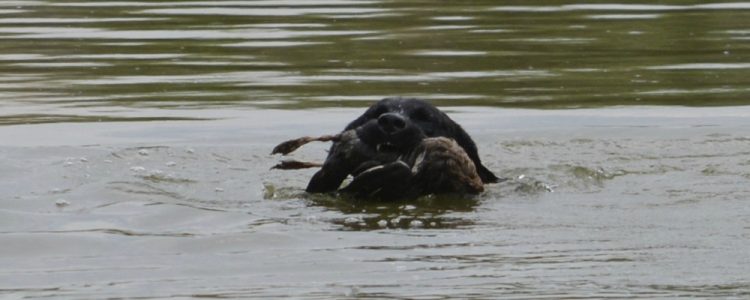
The Working Certificate – or just WC – is a fun test for Labs and their owners. One short retrieve on land and two back-to-back retrieves in water is all that’s needed.
Some Labs take to it (dare I say?) like a duck to water. Other Labs take a bit of coaxing. That’s where being a member of a local Lab club comes in handy.
There’s also a Working Certificate Excellent, or WCX test, offered by some clubs. However the LRC only offers the WC test.
A bit of history
When The Labrador Retriever Club, Inc. was founded in 1931, The Kennel Club in England required sporting dogs prove working ability. Without it they could not earn a conformation title.
Using that as a guideline, the LRC created the WC test. It isn’t a requirement under American Kennel Club rules. However the LRC requires members’ dogs to have a WC before they can be called a show champion.
Requirements of the Working Certificate test
The WC requires your dog to retrieve a single shot bird at 50 yards. Generally pheasants or ducks are used with ducks being the most common. Sometimes pigeons are used.
Usually the birds are already dead and the gunshot is just a simulation. Live birds can be used, however that requires a good gunner and scrupulous safety measures.
This isn’t a marking test like hunt tests and field trials. The core requirement is for your dog to retrieve a bird to you (or at least close to you). The judge will define how close your dog must bring the bird – generally within about five feet of you.
The retrieve doesn’t have to be to hand or fast or even pretty.
Your dog doesn’t have to be steady. You can restrain him by holding his collar or with a leash wrapped through the collar or wrapping your arms around him. For safety, the collar should not have dangling tags. They can be removed or taped securely to the collar.
Handling or directing your dog to the bird with hand signals or other commands is not permitted.
Your dog must also complete two back-to-back water retrieves to show a willingness to re-enter the water.
Download a copy of the WC brochure.
Differences between a WC and a Junior test
This is totally different from an AKC Junior test. It’s not a marking test. It’s only about retrieving. The questions is: Will your dog pick up a duck and bring it back to you?
If he drops the bird ten times, but makes progress back to you and gets the bird into your area, it’s good.
It’s a test of natural ability, not a test of how you trained your dog.
One dog’s experience at the WC
The Labrador Retriever Club of Greater Denver hosted a Working Certificate test near Franktown, Colorado. The property was nicely set up for retriever training. Lots of people and dogs turned out for fresh air and some rather ‘moist’ skies!
Wynk started off with one mark on land – near the top of a little hill – no problem. But there was something new, something she’d never seen before. A blind (camo fabric) out in the field, hiding people.
‘What’s that?,’ she asked. So she had to go take a peek and say hello to the bird boys. Then remembered she had to get her bird back to mom! Scooped it up as she ran back and delivered to hand. Land portion completed!
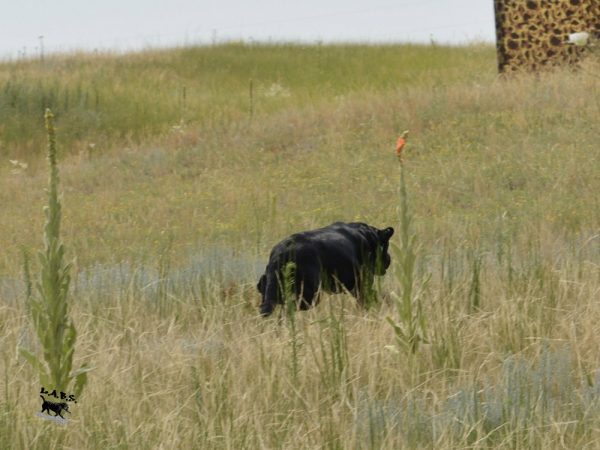
After a bit, we worked the water portion – back to back retrieves in a pond enclosed by tall reeds and other vegetation.
Another new experience for Wynk.
Out and back, delivered to hand for each mark, with her signature squeal as she left the line. Quite proud of my little Lab!
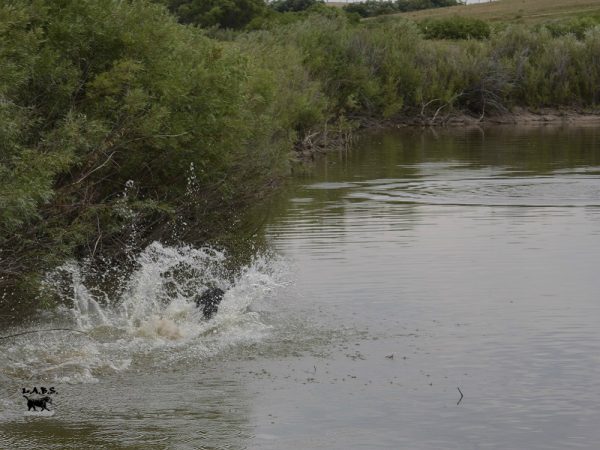
Photos by Linda Alexander.
Preparing for the Working Certificate test
Let’s dive in to the what and how.
Lab clubs often have training days in preparation for an upcoming WC test. If you’re not a member of one you can check for local Lab clubs.
If there isn’t a Lab club nearby, try contacting other retriever clubs. Their training could be different than training for an LRC WC, but they may be able to accommodate your needs. Especially if you volunteer to help set up, throw birds, run a winger station, or tear down.
As a last resort, you can practice on your own. You will need at least one duck and a helper to throw the bird. To start, put your dog on leash and let him see and smell the bird. Waggle it around to get him interested, then toss it about five feet as you run out with him. Praise him for running to it. Praise for picking it up. Let him hold it for a bit. Then repeat, but no more than two or three times.
If it didn’t go too well, try being more excited. Waggle the bird more. Pretend you’re playing keep-away. Have your dog, on leash, watch another dog retrieve the bird. Praise for every tiny improvement.
To use the bird for multiple sessions, wrap it in newspaper and put it in a plastic bag. It will last longer if you freeze it in between sessions. You may also want to warn your family about the foreign object in the freezer.
Land retrieve
Your dog’s manners getting from the holding blind to the line don’t count. Just keep a firm grip on the leash.
It’s a fairly short retrieve of about 50 yards.
The gunner often wears white to be very visible.
Get your dog to sit or stand next to you and facing the gunner. Take your time. When you’re ready, restrain your dog in any way you want. Then signal or say you’re ready.
After that the judge will signal for the gunner to start. Wait for the judge to release you by saying your number or something like “dog.” This gives the judge time to call a “no bird” if something went wrong. You don’t have to release your dog immediately.
The bird will be thrown into light cover and should be relatively easy for your dog to find. There could be a small hunt or, in some cases, a big hunt.
You can encourage your dog. Find it, fetch it up, where is it? are all good. You can use a whistle. You can do almost anything you want to get your dog to pick up the bird and bring it back. Ask the judge if you’re not sure.
The main objective is for your dog to pick up the bird and bring it back to you. The judge may require him to cross a specific line or he might have an area marked out.
Your dog can sit at heel and present the bird. Or drop it near you. Or, if you’re quick and agile enough, you can snag the bird as your dog rockets by you.
Any way you get it, hand the bird to the judge or a “bird boy” and you’re done. For now.
Water retrieves
These test whether your dog will re-enter the water after retrieving the first bird. Again it’s not a marking test. The core requirement is for him to go back in the water to retrieve a second bird.
Each bird is thrown and retrieved separately. It’s not like a double marked test.
Your dog doesn’t have to deliver to hand, but should bring the bird up onto dry land. He can be coaxed if needed to get him into the receiving area. He can also run the bank, but must bring the bird to you.
There’s no rush to do the second retrieve. Get your dog under control and looking out where the next bird is going to be. Signal for the bird when you’re ready.
Once your dog has delivered the second bird to the area of the handler, you’re done. Take a breath!
After all the dogs have run, and your dog passed, you will get a form signed by the judge(s). Send that form to the LRC with the fee (currently $25) to get your working certificate. Some clubs give out their own certificate and/or a rosette to passing dogs to commemorate their success.
Other ways to earn a WC
If there isn’t a Lab club near you that hosts WC tests, here are some alternatives:
- Complete both a land and water series in an AKC licensed field trial or receive a placement or judge’s award of merit in an AKC licensed field trial
- Complete an AKC Junior hunter title
- Earn one leg in an AKC Senior or Master test
And there you have it!
The WC test is a great way to get a feel for running a dog in field events. Young people are encouraged to give it a try. Many experienced handlers had their first taste of field events at a WC test.
It’s also a good way for reputable breeders to show the working ability of their dogs. And it gives Lab owners appreciation for their dog’s abilities without a big commitment to field training.
I hope you will get involved in field work with your Lab. Happy training!
—
This article was originally published on July 24, 2018. Updated on May 10, 2024.
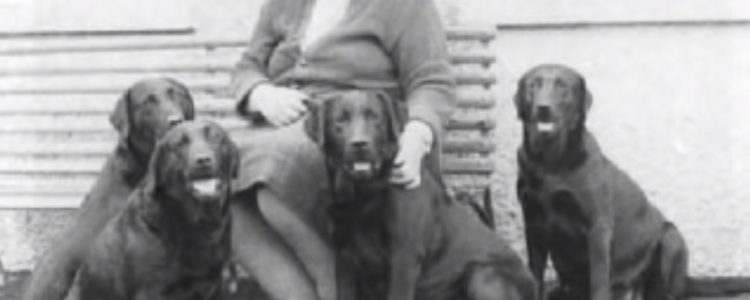
Mary Roslin Williams of Mansergh Gundogs
She bred Labs, she hunted over Labs, she competed with Labs and she taught about Labs. She had seven generations of champions, and 15 or so dogs who won field trial awards.
In the early days, she lived in Mansergh Parish, just south of the Lake District in England.
Mary Roslin Williams taught from practical experience and common sense.
Although she’s no longer with us, she left behind knowledge that she shared. Read a bit and then take a half hour to listen.
The start of the show/field divide
“I started this book by pointing out that at any one time there are about twenty top breeders who can and do stay at the top for many years, but when I come to the breeders who can show their dogs as Championship show-prize winners and also run them in Trials as Trial dogs, accepted as such by the Trial people and not called ‘Bl—y show dogs’ as is their wont, then I find it hard to name twenty kennels that can do this in the last forty years.
“Before the last War there were plenty of strains capable of doing this, indeed it was more or less the norm. The whole atmosphere of Labrador breeding was different, with such people as Lorna, Countess Howe seeing to it that the show Labrador remained a working dog. … The dogs were good-looking on proper Labrador lines, they were thoroughly experienced shooting dogs and cut out their own work with the minimum of help from their handlers, although always ready to take the hint when they were stuck. The good work on the day was put in by the dogs and not the handlers, and while Lady Howe was alive this happy state of affairs, when Trials were fun and you and your dogs welcome, remained until the sad day she died, when we immediately feared and experienced the Great Divide, into entirely show bloodlines and entirely Field Trial, poles apart.”
A water dog
“It’s a great sadness to me, that when they named the Labrador they didn’t call it the ‘Labrador Water Retriever’ … because we forget that the dog is a water dog.
“It’s job was water work. It’s job still is water work and we’ve adopted it and adapted it for different works. But in many countries that we sell our puppies to … they expect that dog to work in water. Very largely. And if you sell a dog to Canada it will be working in water in terrible frost. In cold water. Hours at a time. We ought to remember that, both when we breed and when we judge….
Defining type
“The next thing is the Labrador is a Labrador. Now here is a difficult thing because this is type and however much you have a standard, one thing it cannot describe is type. You’ve got to have type in your head. … Perhaps type varies a little from country to country. …
“My criterion for Labrador type is a very simple one. It must look like a Labrador. It mustn’t look like a Foxhound. It mustn’t look like a Pointer … It mustn’t look like a Golden Retriever. …
Pointer
“You get unmanageability. It’s an outward bound dog. It’s horizon is 300 yards away. It’s hind legs make it gallop because they can’t help galloping. It’s head is held too high. It’s elbow is angulated for a high head carriage and you don’t want it in a Labrador. We used to get it. And besides that we’ve always got a very, very short coat.”
Foxhound
“The Foxhounds came in deliberately. … And what came with it? Arrogance… When he went to judgment, instead of looking at you like a Labrador should – they did that (turned head away) – with the proudest, most arrogant expression. Now that got into the breed very badly, so that we had championship show judges writing in their critique … correct arrogant expression…. It’s absolutely wrong.
“And the other terrible fault we got in there was that they were very fastidious. … They did not like opening their mouths in dirty water. I can’t blame them. I don’t like opening my mouth in dirty water. And I don’t intend to which is why I have a dog…”
Flatcoat
“Now the next thing that happened was that somebody realized this and they quietly moved in a Flatcoat. Now that did a power of good. But we had a Flatcoat influence. One of the reasons why I hate a black eye in a Labrador was that was brought in. We brought in narrow heads, Flatcoat eyes. Flatcoat shaped eyes. And we had a lot of feathering….
“Labrador breeders are so sensible they can get these things out. It took some years and we left the good points in. We lost the arrogance. We lost the hardness and we got dogs that would retrieve nicely again…”
Greyhound
“Now the next thing that came in – and I don’t know where it came in – and I could never get Ronnie Hill to tell me, but what he knew was that the trial people introduced Greyhound. And they introduced Greyhound purely to get the speed.
“Now that influence is still with us. And if you look at the trial Labradors, you’ll see that a lot of them have very, very beautiful necks and shoulders. Marvelous necks. Way, way beyond our reach of neck. Really beautiful necks and shoulders. And they have the deep body, then the tell-tale arch over the loin. And that is the most difficult thing to breed out, to get the field trial arch out of the loin. And then they have long, thin tails and single coats. …
“So I’m warning you, if you use field trial lines you get the virtues, you get the faults, but worse still you get their diseases. And this is why I am so against any Labrador looking like anything – or particularly feeling like anything – when you’re judging that isn’t a Labrador. But as you get in other breeds and you will get in diseases …
“So therefore my first Labrador has been a water dog. My second Labrador, for heaven sake, let it be a Labrador and let it look like a Labrador. Let it behave like a Labrador and feel like a Labrador and work like a Labrador.”
Importance of a correct coat
“… I do wish that everybody … would remember that the Labrador is a cold, wet weather dog and that he’s a water dog. And that it should be able to go out duck flighting in January in bitter, bitter weather sitting at the bottom of a cut in the sand with water up to its belly or even up to its neck. The tide coming in or out and it has to sit there for while the duck flighting in. A it is cold and it is wet and the dog must be able to stand it.
“…Please remember that that is the job of a Labrador. And they should have a proper coat. And it should coat them all over. [Some dogs] are half coated. They have a hard, hard ripple like a table runner down their backs. Very, very hard hair and they have nothing else. … And that is not a Labrador coat. The Labrador coat should cover all over to the same depth and be dense, but they’re very, very difficult to find now…
Why correct structure is important
“… a Labrador’s job is not to hunt in front of you, flushing rabbits, flushing pheasants, however good.
“It is not to be a guide dog for the blind.
“It is not to be a dog for finding drugs or any of these useful things [like] finding … a dead body… That’s not it’s job.
“It’s very nice of it to do it… but it is not it’s job.
“It’s job is to sit or walk at heel until told to go. And it’s only told to go either at the end of the drive or when the bird comes down if you’re in … a duck blind … and you want it to go. …”
A level back
“And for that you need a dog bred on exactly classical lines. And a classical line is a level back, not a rake. A level back. Any retrieving dog that has to also mark should have a level back. …
The neck
“It should have a longer back to its neck than to it’s throatline. … It should have an 11″ back to its neck and a 4″ throatline, not an 11″ throatline and 4” back.
“If it was a horse it would be putting it’s ear in your mouth…
“It’s very dangerous for a Labrador to have that enormous exposed windpipe… And then when they pick their bird, it stands to reason that… the long line is on the top and the short line is underneath.
The shoulders and angulation
“Now the shoulders should be laid back and this is very important too.
“In a pointing setter, they have a laid back shoulder. Fair enough. But they don’t have the classical right angle at the point of the shoulder. They are over angulated… We want the right angle or thereabouts give or take a few degrees.
“If you have a laid back shoulder, a right angle there and a level back … the foreleg comes back under the girth. It’s not under their ear and neither is it straight under the point of the shoulder. It is back and the elbow is under the girth.
“So there you have the exact angulation that the dog can easily mark the bird when he’s walking because it’s easy for him to have his head up. He can get a scent within a reasonable distance… and then put his head down. And he can get his head down perfectly easily without having to put his elbow out… So therefore you’ve got a perfect mechanism there.
“And he must have that long line on the top of his neck to pick his bird. He then picks his bird – which takes a lot of strength – and gets it back onto the layback of his shoulders easily carrying it on the layback of his shoulders.
“So if you have the classical front, that is exactly right for a Labrador, a Golden, a Flatcoat, a Curly, a Ches, but it isn’t right for a Pointer and Setter. And it isn’t right for a Foxhound. They have their own fronts, slightly open.
An example of why it matters
“… if you have an over angulated shoulder with open angles, like a Pointer and Setter – I’m citing one of my own dogs now.
“I had a lovely dog name Tarmac … and a very good worker. But I can cite him because he was wrongly made.
“He had a marvelously erect shoulder. He then had a raked back. And the consequence was that he was over angulated behind so that he had too much stifle and too much hock – too long a hock – and it was too far behind him. And that is what happens when you get a raked back.
“Now that was the most rightful inconvenience to him when he was swimming because he swam like a Pointer. …
“He was all right once he got the bird in his mouth, but when he didn’t have a bird in his mouth the fact that he didn’t have a level back and that he had an over angulated hind legs…, he had difficulty in the water work. So I know from experience that is not a good thing. …
“At one time because we had a craze for very, very short backs – which … is not short coupled, the word ‘short-coupled’ means the loin. … they were absolutely cramming dogs so close together that they had no where to put their feet when they ran. .. They were crabbing and they had a very short line … from the point of the hip to the point of the buttock, they had no rumps whatsoever.
“And I am quite certain for work – particularly swimming – you must have a decent balanced length from the point of the hip to the point of the buttock. …
Stance
“Now if you’ve got your backline right, then you’re going to have your angulation just about right.
“And it’s well to remember – again – that a Labrador is not meant to stand with it’s legs out behind it like a Pointer or a Setter. They’re meant to stand more or less under the point of the buttock. “In other words the dog is standing slightly over his leg and he mustn’t stand sickle-hocked with his feet too far forward.
“And a very important point, … for a perfectly balanced dog … from the hock to the ground … should be at exact right angles to the ground – not stretched out back, nor sickle underneath. …
“If that dog drops it’s hock correctly, then it is standing absolutely correct on it’s feet and you’re less likely to have foot trouble.
“… If you’ve got your angulation right and your level back, you’ve got a balanced dog standing on it’s feet correctly with it’s weight very, very slightly on it’s hocks … and it should stand in a position … that it could jump in any direction immediately. It can either jump forward or backwards or to either side because it’s slightly on it’s hocks.
“Those, to me, are the salient points of a Labrador’s conformation. …
“And besides that, …it has to have a tender mouth and the ability to retrieve, the ability to mark and a thousand other things that you have in field trials and it’s like trying to get your football pools right. You’ll never do it, but we try.”
# # #
For a fun walk down memory lane, read some reminiscences from MRW’s daughter, Anne.
Would you like to learn even more? MRW wrote two books – and although they can be hard to find and expensive – they are worth the effort.
Advanced Labrador Breeding (aka Reaching for the Stars)
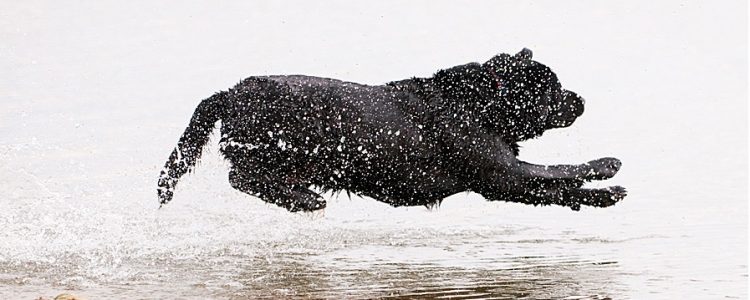
The last local AKC retriever hunting test of the season is in the books.
Beautiful property with fabulous water, good weather (yes, a bit hot) and lots of great dogs and their handlers.
There was even a chocolate Lab I’ve got my eye on!
My co-judge, Jeff Baldwin, drove all the way from Utah to bake in the high plains sun. Wyoming kindly sent us some of their wind every afternoon.
We designed the Senior hunting test on Friday. Jeff judged Junior on Saturday while I worked at Master. On Sunday we judged Senior together.
It was a long weekend.
What did we set up and why?
The requirements for an AKC Senior hunt test are:
- a double retrieve on land
- a double retrieve on water
- a land blind
- a water blind
- an honor
Then we had to throw in a live flyer, a walk-up, a diversion shot and multiple decoys. Plus adding some other trappings to simulate a real bird hunt. (See the Glossary below.)
We chose to start off with the land series in the morning. Having the water series afterward gave the dogs a chance to cool off in the afternoon heat.
The first two photos were taken from the “line” – the spot where handlers bring their dogs to start the test.
To begin, we called for a “handler’s meeting” to introduce ourselves and describe the test. Often there are several questions.
Next we ran a “test dog” (a dog who was not in contention). He ran the test to make sure everything worked as planned and to show the handlers the test set up.
Of course, the dogs in contention didn’t get to watch!
After completing the two marks successfully, the test dog and handler moved to the “honor box” which is a spot nearby where the dog can watch the next dog work.
This is often a challenge for dogs at this level.
Having just completed two retrieves the honor dog is often excited, but must be “steady” (remain quietly in place) off leash. He must watch the next dog retrieve at least the first mark.
Starting the Senior Hunting Test
Next the handlers lined up in “holding blinds” (fabric set up to block the dog’s view of the test). AKC suggests dogs run in catalog order. However some handlers run dogs in other stakes and may need to run out of order.
When we were ready, we asked the handler in the final holding blind for the dog’s number. Leashes come off before leaving that holding blind to run the test.
To simulate a real hunt, handlers had to shoulder and point a shotgun as each bird was thrown. The handler’s gun is usually disabled for safety, but must be treated as a loaded gun. That applies even if the “gun” is only a wooden cutout.
When the handler signaled they were ready, we had bird tech #1 throw the first bird. This was a duck from a winger hidden behind a clump of trees near the left side of the field.

The bird went from right to left and landed in some rather sparse cover, about 70 yards away. Just before throwing the bird, the bird tech blew a duck call and shot a blank to get the dog’s attention. There were also multiple goose decoys the dogs had to run through to get to the bird.
Many dogs wanted to retrieve right away, but they had to be steady and wait for the second bird to be thrown – a “double retrieve.” This bird was a “flyer” (a live bird that was thrown and then shot in the air) which is very exciting for the dogs. All the other birds were already dead before being thrown.
The second bird
Bird #2 came out of a winger hidden behind the berm that ran parallel to and behind the line of trees. Flyers rarely land in exactly the same place so the distance to the bird varied, but averaged about 60 yards.

Because of the excitement caused by a live flyer, several dogs “broke” (ran to retrieve it before the handler’s command). Dogs that retrieved the bird without being released were disqualified. However if the handler was able to stop the dog quickly (within about 15 feet) they were allowed to continue. They were penalized for a “controlled break.”
Some dogs didn’t break, but moved a little bit towards the birds. This is called a “creep” and is penalized, but less than for a controlled break. Dogs moving beyond the length of the gun barrel had to return to heel before they could retrieve.
After both birds were down, we had the handler send their dog. They could pick up the birds in any order, but usually chose to get the last bird down first. This is especially so when that bird is a flyer!
After delivering one of the birds “to hand” they were sent to retrieve the other bird. When the working dog was sent on the first retrieve, we dismissed the honor dog.
If the working dog did a passable job on the double retrieve, they next had a “blind retrieve.”
Problems
Sometimes dogs forgot where a bird landed and had a big hunt or ran towards where they already found a bird.
Returning to an old fall and switching are both disqualifications. They are similar faults. “Returning to an old fall” is going back to where they already retrieved a bird. “Switching” is abandoning a hunt for one bird to go to a different bird.
When a dog hunted too far away from the bird or started toward the other bird, handlers blew their whistle. At that point the dog was handled to the bird using the same technique as a “blind retrieve.” This means directing the dog to a bird he didn’t see fall.
The blind retrieve
We “planted the blind” (placed a bird in the field when the dog wasn’t watching) near a bush 50 yards away.
To get to the blind, the dog had to pass some larger bushes and diagonally cross a dirt track. The location was to the left of bird #1 and slightly out of the left side of the first photo.
For a passing score, the handlers had to “challenge the blind.” This means keeping their dogs close to a direct line to the blind. Dogs should not run all around in hopes that he would eventually find it on his own.
Dogs were penalized if they didn’t:
- stop on the whistle
- take the correct cast
- maintain the new direction for at least a few yards.
Senior dogs are at an intermediate level of training and still learning so each penalty was only a minor deduction.
Thirty-one dogs did a double retrieve, blind retrieve and an honor. Twenty-nine competed plus a test dog (honored the first dog) and a bye dog (retrieved while the last dog honored).
Dogs that had a passing score on land were “called back” to run the water series.
The water series
We moved a 1/4 mile south to a spit of land. There was a water channel on the left side and open water on the right.
This series included a double retrieve and a blind retrieve with a walk-up and a diversion shot. No honor, no live birds.

To start, the handler walked down the spit with their dog at heel. When they got to a certain point, there was a gun shot and a bird was hand thrown. It landed in grass about 8-10 inches tall and about 4-6 feet from the water’s edge.
The second bird came out slightly left to right, with another gun shot. It landed with a splash about half way down the channel. Both bird techs were hidden behind tall bushes.
The dogs could retrieve the birds in any order. When they were returning with bird #1, there was a diversion shot to set up the blind.
Most dogs did fairly well to great on the water double retrieve. There were a few that needed to be handled to one of the birds. A few dogs needed to be handled to the memory bird on land and one of the birds on water.
The blind was across to another spit of land and was placed just out of the water.
There was some suction to old falls and to a bit of land poking out of the water. Otherwise this was a straight forward blind. All the dogs who attempted it did fine.
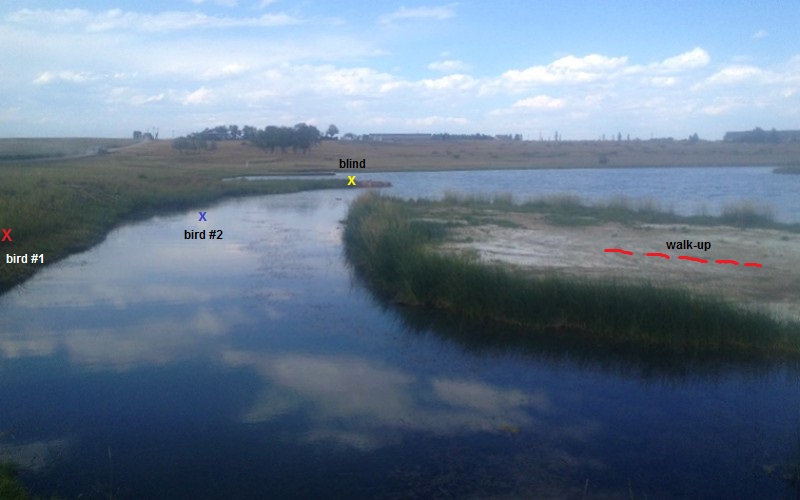
Summing up…
Our goal was to make both series as hunt-like as possible while staying within AKC’s rules for a Senior hunting test.
We also wanted the handlers and dogs to enjoy it and to make sure everyone was safe.
Some dogs did very well overall. Other dogs did better on one series or the other. And some dogs had enough trouble that we couldn’t give them a ribbon this time.
I’m grateful to the Mile High Golden Retriever Club for asking me to judge. To the owners and handlers who entered their dogs. To all the helpers for handling the myriad of jobs. And to my co-judge who made it so easy, it felt like we’ve been working together for years.
By the way, all of my dogs got to experience that great water.
The adult dogs loved it. The younger ones quickly learned that the end of grass doesn’t always mean there’s a gentle slope into shallow water. However they did get to practice new swimming skills.
And the drive home was rather quiet – except for some snoring coming from the back.
Update: I’m sad to say Jeff has left the bonds of Earth. I hope he’s been reunited with family and friends and, of course, his favorite dogs. We miss him greatly.
Glossary for a Senior hunt test
BLIND RETRIEVE – The dog is sent to retrieve a bird that it did not see fall. The dog is expected to take hand, voice and whistle signals to direct it to the bird.
DIVERSION – Either a shot or a fall designed to divert the dog’s attention from the task at hand.
DOUBLE – Two birds to retrieve.
HONOR – Dog to sit quietly off-leash on or near the line while another dog retrieves.
MARK – A retrieve that the dog has seen fall.
MEMORY BIRD – First bird the dog sees thrown/shot on a multiple mark. Usually the last retrieved.
STEADY – Dog does not leave assigned spot until instructed by the handler to retrieve.
WALK-UP – Bird is thrown while handler and dog are walking with the dog at heel, much like jump shooting.
By: Rich Carpenter
You can see the entire glossary on the Platte Valley HRC’s website.
Originally published September 22, 2018.
You might also like –
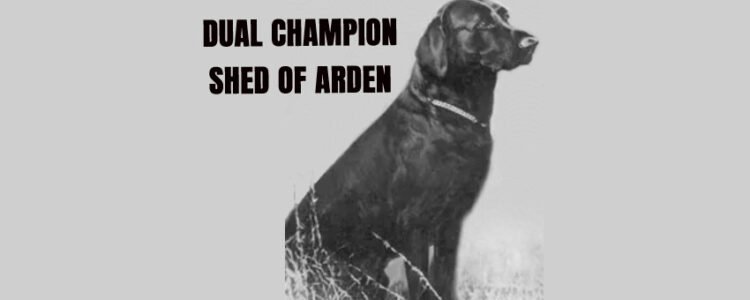
“Shed of Arden’s qualities were of the highest: he epitomized an ideal.
…By those who are knowledgeable, he was considered to have embodied the greatest qualities a Retriever can possess in equal parts: looks, performance, and the priceless gift to transmit these from generation to generation.”
~ Helen Warwick, Lockerbie Labradors
Shed of Arden’s story
3xNFC CFC DUAL CH Shed of Arden is one of the best-known Labrador Retrievers in history, but what do we know about him and his family?
Shed was born March 26, 1939, and bred by William Averell Harriman who owned Arden kennels. Paul Bakewell III of Deer Creek Kennels bought Shed as a young dog.
There’s a story that his siblings were all named for fish and that he was supposed to be Shad of Arden. Due to a clerical error he became Shed instead.
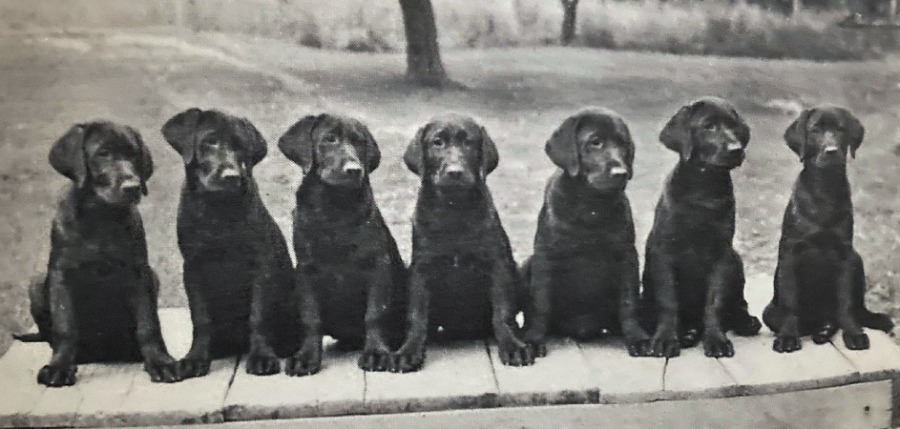
The Arden ‘fish’ litter, including Shed, Bass, Marlin, Trout.
Competition
Show competition
Although Shed often competed in the show ring and field at the same time, he started his career in the show ring. At 14 months old he won Winners Dog and Best of Winners for a 5-point major at the Labrador Retriever Club’s specialty show in 1940. His older brother, CH Earlsmoor Moor of Arden, won Best in Specialty at that show. A week later the brothers repeated their wins at another show with another major for Shed.
He finished his show championship 15 months later with two Best of Breed wins and a Group 4th.
Field Competition
Retriever field trials in America were still in their infancy when Shed was born. It was only nine years since his uncle, NFC Blind of Arden, won the first field trial.
Shed started his field career with a Derby second at 20 months, still owned by his breeder.
The next year he started earning points in field competition. By the fall of 1942, he had finished his field championship to become a dual champion. He also qualified for the National Retriever Championship.
National Championship 1942
As a 3-year-old, Shed won his first National Championship. He was handled by Lt. Bakewell who was on leave from the Navy Air Corps.
Madison, Wisconsin hosted the National on December 4-6, 1942. The weather was cold. “The Yahara River and adjoining marshes which ordinarily afforded everything desired for water tests were frozen solid…. This necessitated moving the water tests to the University of Wisconsin property along the shores of Lake Mendota. Heavy ice floes made it dangerous for dogs to get into the water. Several refused to enter, others only after repeated commands.” 1
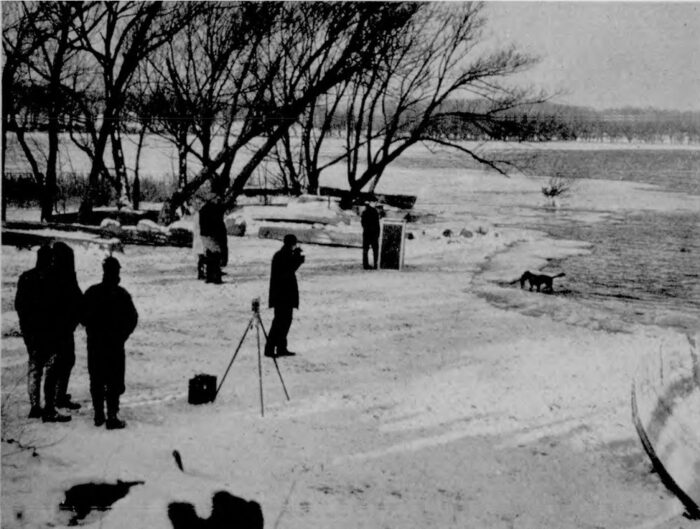
Icy conditions on Lake Mendota. Photo courtesy American Kennel Gazette.
“The weather was bitter and difficult on the great gallery, but it was weather to be expected in the final week of the Wisconsin duck hunting season and no dog who could not meet these conditions could rightfully aspire to the national title.” 2
“To win, Shed had to show supreme ability to bound over frozen hummocks in quest of pheasants and to break sheets of ice in swimming after ducks. In fact, it is hard to imagine more trying conditions than those which the dogs, their handlers and the gallery faced during the three days of the stake. The thermometer was never far from zero, and frequently was below that mark….” 3
Eighteen dogs started, but only five finished, including two owned by Bakewell – Shed and FC Stilrovin Super Speed. The other finishers were FC Hiwood Mike, Patricia of Roedare, and Seaborne’s Black Prince.
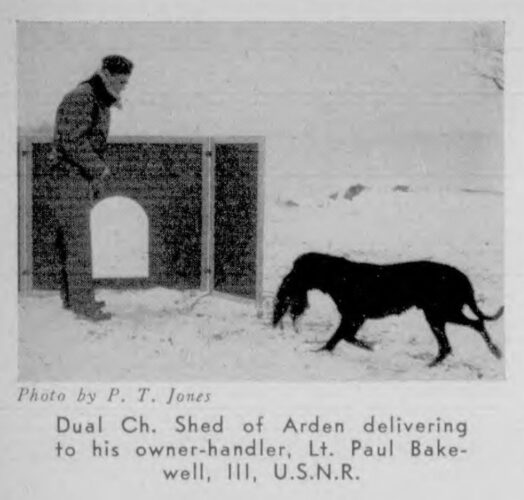
Shed of Arden delivering a bird. Photo courtesy American Kennel Gazette.
“Throughout the meeting Shed did everything asked of him, and did it brilliantly. Probably the thing that most pleased the gallery was the way that willingness was demonstrated when, in the final water test, he never hesitated a minute in crashing his way out through brittle ice…” 4
National Championship 1943
Shed won the National Championship again the next year. He was handled by Clifford H. Wallace because Lt. Bakewell was on active duty.
Bourbon, Missouri hosted the stake on December 3-5, 1943. Twenty dogs started, of those 15 were Labs and five were Goldens. It took two extra series to determine the winner between two dogs – Shed and a Golden Retriever named FC Stilrovin Super Speed. Both dogs were owned by Lt. Bakewell.
Cotton Pershall trained Shed until until it was time to join the Army. At that point, Clifford Wallace took over and guided Shed through the grueling tests in Missouri.
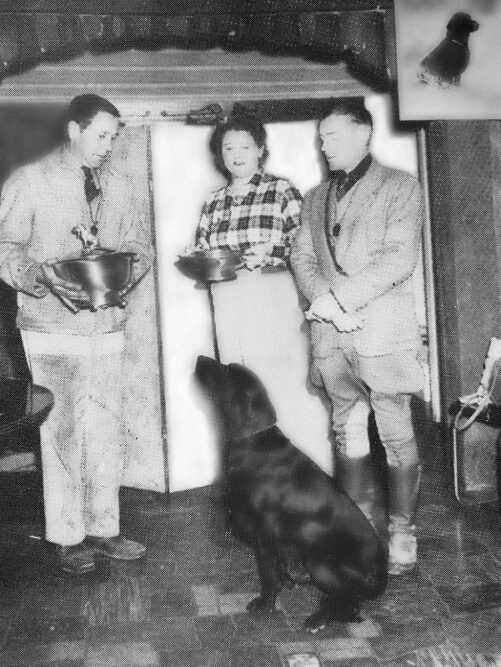
Mrs. Bakewell with Shed and handler C.H. Wallace. Presenting the trophy was M.B. Wallace Jr, trail chairman. Photo courtesy American Kennel Gazette.
Shed didn’t compete in the 1944 National. However, he did travel to Vancouver, British Columbia in October where he finished his Canadian Field Championship.
National Championship 1945
World War II ended in 1945 after Germany surrendered in May and Japan surrendered in September. That November Shed and Bakewell were back to compete in the National Championship. This time it was held at Shelter Island, Long Island, New York, which meant a daily ferry ride from Riverhead. The stake was held on November 30-December 2, 1945.
The first day brought blinding snow and sleet which limited the day to only one series. The second day was cold and windy with high tides and northerly winds. The judges ran land tests in the morning and water tests as the tide ebbed. Despite the conditions, only six dogs were dropped.
Although Shed was a finalist, the judges awarded the win to Black Magic of Audlon.
National Championship 1946
Shed was now seven-years-old, but he continued competing at trials around the country. At a trial in Oregon he had a 300-yard blind retrieve across the tip of a lake for a shackled duck planted several yards off the shore. He was one of only six dogs to complete the series.
In the fall of 1946, Shed reclaimed his crown and is the only three-time winner of the National Championship. It was held on December 6-8. The grounds were good at Crab Orchard Lake, Herrin, Illinois, as was the weather. This is a coal mining area, and the mines were on strike at the time of the National. “… the gallery was augmented by many hundred miners who came to see the event. Some estimated the gallery at 10,000. Traffic presented a bit of a problem.” 5
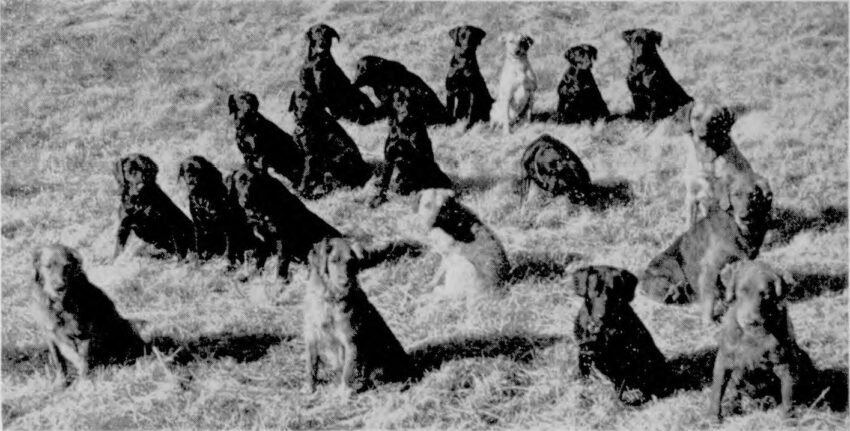
The 20 dogs entered in the 1946 National Championship Stake. Photo courtesy American Kennel Gazette.
Twenty dogs started the stake and eight finished.
In the final series, Shed faced off against three tough competitors. They were his kennel mate, Dual Champion Little Pierre of Deer Creek, plus FC Scoronine of Deer Creek, and a Golden retriever named Stilrovin Nitro Express.
“Scoronine led the field until the last day, then refused to plunge into the 45° water. Now it was Shed’s turn.
“In the toughest test, he had to find two dead ducks which had been planted among the rushes across a 150-foot-wide bay. Shed waited calmly at the water’s edge until he got the signal from Bakewell. Then he plunged bravely into chilly Crab Orchard Lake, but not with his old zip.
“… One-third of the way across, Shed’s black head turned at a whistle from Bakewell to get directions. He entered the cattails just six feet from where the mallard was hidden, sniffed for a second, found his bird. A few minutes later, Shed did it again, and won his third U.S. championship.” 6
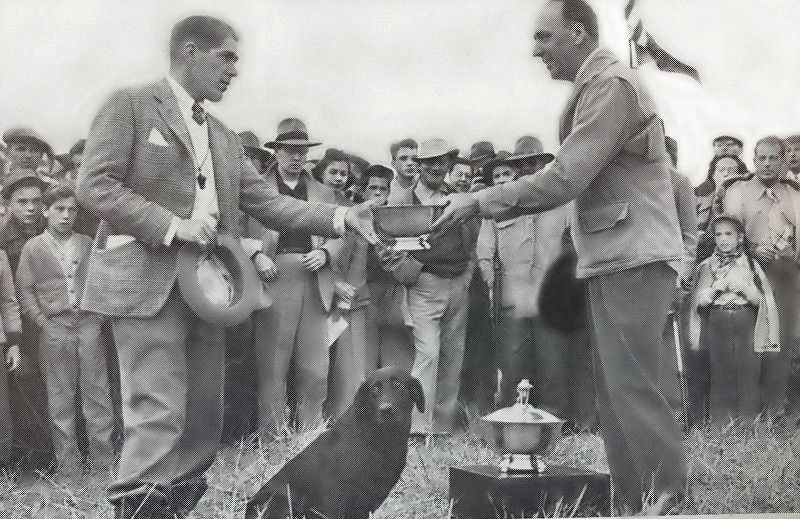
Paul Bakewell received the championship trophy for Shed’s third national championship win.
National Championship 1947
Shed ran the National Championship one more time. The 1947 National was again held at Crab Orchard Lake, Herrin, Illinois. The weather was good with only occasional light rain. Twenty one dogs started, but only four dogs finished. These dogs completed the tenth – and the eleventh – and the twelfth series in an effort to determine the winner. The final series was completed in near darkness.
These dogs were:
FC Black Panther, owned by CW Carlson
FC Black Roland of Koshkonong, owned by Wesley Jung
FC Bracken’s Sweep, owned by DE Pomeroy
DUAL CH & 1942 , 1943, 1946 NATL CH Shed of Arden, owned by Paul Bakewell
Bracken’s Sweep, handled by TW “Cotton” Pershall, was crowned the winner.
Shed’s Family
| CH Raffles of Earlsmoor | Thatch of Whitmore CCW | Eng DUAL CH Titus of Whitmore |
| Tee of Whitmore | ||
| Task of Whitmore CCW | Toi of Whitmore FTW | |
| Eng CH Teazle of Whitmore | ||
| FC Decoy of Arden | Odds On FTW | The Favorite FTW |
| Jest | ||
| Peggy of Shipton FTW | Ronald of Candahar | |
| Gehta of Sigeforda |
His parents
Shed’s sire, Raffles, was Dr. Samuel Milbank’s first Labrador although dogs were always part of his life. His father, Dr. Milbank, Sr., bred Chesapeake Bay Retrievers and terriers.
A Scottish surgeon started the junior Dr. Milbank into Labradors when he found and shipped Raffles to him. According to Helen Warwick in The Complete Labrador Retriever, importing Raffles “started a collaboration of Dr. Milbank and W.A. Harriman that molded the fortunes of the Arden kennel, setting a precedent for quality that has never been equaled by any other Labrador Kennel in America.”
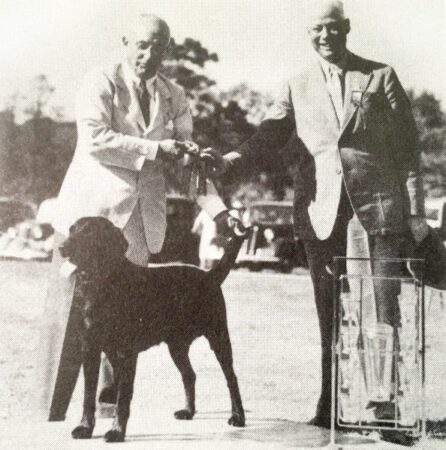
Show champion Raffles of Earlsmoor
Decoy, Shed’s mother, was the second Lab to earn a field trial championship in America. Her full brother, Blind of Arden was the first to earn a field trial championship and also won the first US retriever field stake in 1938.
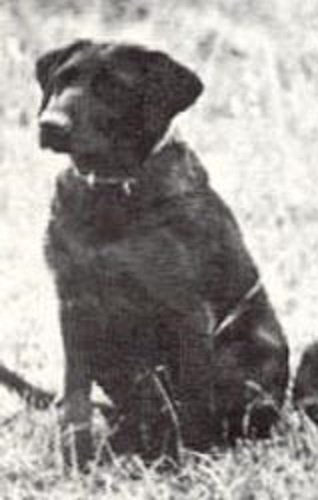
Field champion Decoy of Arden
Shed descends multiple times from well-known Labs such as English field trial champions Flapper and Peter of Faskally plus the first dual champion Banchory Bolo.
His siblings
Some of Shed’s full siblings included:
- CH Earlsmoor Moor of Arden
- CH Earlsmoor Marlin of Arden
- DUAL CH Gorse of Arden
- DUAL CH Braes of Arden
- CH Bass of Arden
Half siblings included:
- FC Gun of Arden
– Grandsire of 2xNFC Spirit Lake Duke and great-grandsire of DUAL CH CFC Ridgewood Playboy and CH Whygin Gentle Julia Of Avec - Marvadel Cinders
– Dam of Can DUAL CH Coastal Charger of Deer Creek and NFC AFC Marvadel Black Gum
His titled offspring include:
CNFC FC AFC Ardyn’s Ace of Merwalfin
FC AFC Bigstone Bandit
CFC Chanbar Jigaboo ***
CH Chukker of Bonniehurst
NFC AFC Creole Sister
FC Dacity Bill
CH Dauntless of Deer Creek
CH Deer Creek Black Ace
FC Firelei’s Hornet
FC CFC Jibodad Gypsy
CFC Nelson’s Black Prince
FC Pickpocket for Deer Creek
CH Snikeb’s Cookie
CH Trixie’s Black Cargo ***
CH Wardwyn Jackpot
Shed’s descendants at Justamere Ranch:
Chip descends multiple times from Shed. Those bloodlines include:
Dual and field champions –
NFC Dual CH CFC Bracken’s Sweep
Dual CH Grangemead Precocious
CFC Chuck of Bracken
FC Dacity Bill
FC Freehaven Muscles
FC Gilmore’s Peggy
FC Shoremeadow Tidewater
FC AFC Tar Baby of Hilly Hill
Dee also descends multiple times from Shed. Those bloodlines include:
Dual champions –
Dual CH AFC Alpine Cherokee Rocket
Dual CH Cherokee Buck
Dual CH Grangemead Precocious
Dual CH Ridgewood Playboy
Can Dual CH Coastal Charger of Deer Creek
Can Dual CH Dart of Netley Creek
Field champions –
FC AFC Air Express
FC Beautywood’s Carbon Copy
CNFC FC AFC Belle of Zenith
FC AFC Bigstone Bandit
NAFC FC Bracken’s High Flyer
FC AFC Canis Major’s River Bear
NFC AFC CFC Cork of Oakwood Lane
FC AFC Cougar’s Rocket
CFC Crevamoy Iron Duke
2xNAFC FC Dee’s Dandy Dude
FC Deer Creek’s Bewise
2xNFC CNFC AFC Del-Tone Colvin
NAFC FC Dude’s Double or Nothin’
FC Firelei’s Hornet
FC Freehaven Muscles
FC Gilmore’s Peggy
FC AFC Ginger’s Choc August
FC AFC CFC Grady’s Shady Ladee
NAFC FC CFC Guy’s Bitterroot Lucky
AFC Jilly Girl
FC AFC Les Coup De Grace TD
FC Luka of Casey’s Rocket
FC Martens Mister Nifty
FC AFC Mon Tour De Force
FC Mueller’s Stormy Canada
FC Nelgard’s Counter Point
CFC Nelson’s Black Prince
FC AFC Paha-Sapa Chief II
AFC Penny Girl
FC AFC Raider’s Piper Cub
FC AFC Rip’s Bingo
2xNAFC 3x CNFC FC River Oaks Corky
NAFC FC River Oaks Rascal
FC AFC River Oaks Way-Da-Go Rocky
FC Roy’s Rowdy
FC AFC Serrana Sootana of Genesee
FC AFC Shed’s Prince of Garfield
NFC 2xNAFC Super Chief
FC AFC Tar Baby of Holly Hill
2xCNFC AFC Tar Baby’s Little Sweet Stuff
FC AFC CFC Trieven Thunderhead
FC AFC CFC Triple Echo
FC AFC Trumarc’s Raider
AFC Westwinds Shadow of Hope
2x NFC Whygin Cork’s Coot
CNFC FC AFC Yankee Clipper of Reo Raj
FC Zipper Dee Doo
Show champions –
CH Dauntless of Deer Creek
CH Rupert Dahomey
CH Whygin Poppitt
CH Woodcroft Daisy
Conclusion
During his career, Shed earned both US and Canadian Field Championships and a US show championship which qualified him as a DUAL champion. He also ran in five national field championships – winning three times and finishing as a finalist the other two times. At one point his owner turned down an offer to buy him for $10,000 (equivalent of about $150,000 today).
Sometimes the descriptions of field trials from years ago sound more like hunt tests. Don’t be fooled. The tests were real hunting scenarios. On the East Coast, birds were often thrown from a boat well out in the mouth of a bay. An outgoing tide could carry that bird out even farther. Trials were held even if the temperature was below zero, but jumping into frigid water and breaking ice was one of Shed’s specialties. A trial he won as a seven-year-old, included “a 300-yard blind retrieve across the eastern tip of the lake for a shackled duck that was planted several yards from the opposite shore.” 7
He was a good ‘un.
3xNational Field Champion, Canadian Field Champion, Dual Champion Shed of Arden
Whelped: March 26, 1939
Owner: Lt. Paul Bakewell III, Deer Creek Kennel
Breeder: W. Averill Harriman, Arden Kennel
Registration: A-330767
Abbreviations:
CH – Show champion
FC – Field trial champion
NFC – National field trial champion
CCW – English Conformation Certificate winner (not a title)
FTW – English Field trial winner (not a title)
CFC – Canadian field champion
Notes:
[1] The National Retriever Field Trial Club, 1941-1960, 62.
[2] “Victory Well Earned”, New York Times December 12, 1942
[3] “Dual Ch. Shed of Arden Wins Retriever Championship”, American Kennel Gazette, January 1943, 65.
[4] Ibid
[5] The National Retriever Field Club, 1941-1960, 79.
[6] “Sport: An Old Dog’s Day”, Time magazine, December 23, 1946
[7] “Shed of Arden Wins Oregon Open All-Age”, American Kennel Gazette, June 1946, 92.
We had a great weekend – despite the heat and wind near Boone, CO at an HRC hunt test. Arwen passed a tough Finished test, Tory passed his third Seasoned test, and Jazzy got to run two Started tests and passed both!
Finished test
The Finished test started with a wide-open triple retrieve and a diversion as the dog returned with the last bird. Although it was called a dove hunt, we rarely use any birds except ducks because they hold up better. I’ve seen pigeons or chukar used on rare occasions, but only for the land retrieves.
After the triple we did a blind retrieve with lots of suction to the nearby dike and to the old falls.
Arwen did fabulously in this series! And I, crack shot that I am, knocked down every bird I shot at.*
Finished, Part two
When all the dogs completed the “dove hunt” land series we moved to the water series with ducks. This series was a mind-bender trying to remember which bird is shot at by which handler and which dog got to retrieve.
It started off with a buddy on the honor bucket as Arwen and I walked down the muddy path. On the way, a duck came sailing in from the left. Both handlers shot at it, but remembering not to shoot in the direction of the other handler! The honor dog picked up that bird while the working dog (Arwen) had to watch.
Once we got settled on a bucket, a duck came in over our right shoulder. Followed quickly by another duck that came in from the left. Both handlers shot at the birds. Arwen picked up the left bird after a long swim, then rooted the right bird out of the reeds.
Somehow with all that “shooting” we put down another bird way off to the left. This set up a blind retrieve. The line to the bird was just off the beach with suction to the shore and to the old fall. With a couple whistles to keep a tight line, Arwen picked up that bird.
Time for a new “hunting buddy.” As he came down the path with his dog, we moved to the honor bucket, but this dog was amped! When he came into sight Arwen must have figured she’d need a head start to beat him to HER birds. She took a few steps toward the water during the double, but luckily decided not to go any further. Good dog!
Thanks to judges Erik Brekke and Tim Boies for a fun test!
Seasoned test
Seasoned is a pretty big step up from Started. There are five tests: a walk-up, double land mark, land blind, double water mark, and a water blind. There’s also a diversion bird.
Tory did well on the water blind, but needed a handle on the water memory bird (as did most dogs). The walk-up was along the tree line, followed by a double mark with a diversion bird. Then a walk back to the first side of the trees for the land blind. Tory did great on all of it.
The hardest part was the long wait to get through the five tests for all of the dogs.
Thanks to judges Faron Eddy and Bob Moreschini!
Started test
The Started test began on the very muddy shore of a large pond. My friend was one of the first handlers to run the test and it was her first test. She did great, except for not letting go of her dog’s collar in time.
Boots stuck in the mud and her dog leaping forward led to a full body splat in the mud. After cleaning up, she went to try again only to be told by a judge that her dog failed. As a judge myself, I disagree with that judge’s decision. Started often has beginning level dogs and inexperienced handlers. For the sport to survive, we need to encourage new people. I applaud my friend’s courage to try again and to continue running her dog to complete his Started title.
My dog, Jazzy, did great on the water marks, although I teetered a bit in the mud. She also did great on the land marks, but was a little sticky on one bird. However I wasn’t too concerned as it was the first time she’d retrieved a pigeon. Before this test she had only retrieved bumpers and ducks.
*Note: We don’t use live ammunition in HRC hunt tests. There is an exception for Upland tests which uses live birds. Even in that case only designated shooters have live ammo. Handlers have blanks, but must treat all guns as if they’re loaded.
Conclusion
If you haven’t been to an HRC hunt test and would like to learn more, check out the Hunting Retriever Club’s website. There is also information about local clubs. Check if there’s a club near you and see if you can join them on a training day.
Another option is to search for hunt test videos on YouTube. There are quite a few to choose from, plus more videos about AKC hunt tests.
Originally published May 25, 2010.
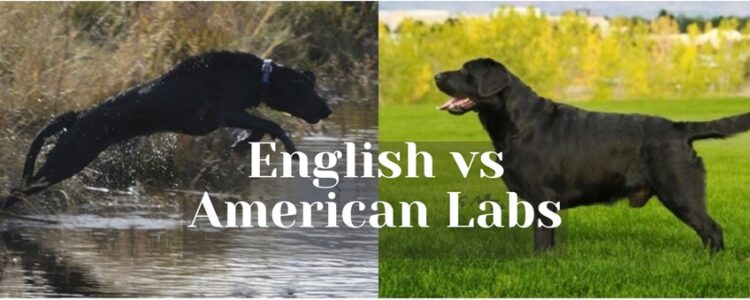
As a long-time Labrador fan, I’ve owned both the English vs American styles. Some people call them “show” or “field” Labs, as that can be less confusing.
So, what makes one dog an English Lab and another an American Lab? This guide will explain what happened.
Early Labradors in America
From the 1930s when the first Labs were imported through the 1970s, field Labs and show Labs were virtually the same. It was common for show dogs to be bred to field dogs. Even Ebonstar Lean Mac, one of the best-known field trial Labs, descends from show dogs.
Often, individual dogs were a bit better at one sport or the other, but some were good at both. During that time there were 37 Labs that earned both a show championship and a field championship to become Dual Champions.
What Caused The Split
In the 1970s and 1980s, a second wave of British imports began. Some of these dogs were heavier-bodied with blocky heads. Show fanciers in America flocked to them hoping to breed the next big winner.
Meanwhile, field trials were changing. The landscape here is bigger and more open than in England so dogs needed to go farther and faster to win.
Thus started the divergence. Show dogs became shorter and heavier. Field dogs became taller and lighter.
Because show dogs of that time had imported English blood, they were called “English Labs.” Originally only the imported dogs were called English, but over time all show-type Labs were called English. Other Labs were called American.
English vs American – Physical Differences
During three decades as the most popular breed in America, striking differences developed between the English vs American styles.
These physical differences aren’t just cosmetic, they reflect the different purposes for which the English vs American Labs were bred.
English Labs were bred for show rings, while American Labs were developed for their hunting and field trial abilities.
Energy level
Both English and American Labs are highly trainable, but their different energy levels can affect their training needs.
English Labs:
- Often easier to train for basic obedience
- May be more patient with children and other pets
- Good for therapy work and as emotional support animals
American Labs:
- Great at advanced training and complex tasks
- Thrives on plenty of physical and mental stimulation
- Good for active families and outdoor enthusiasts
Temperament
Both English and American Labs share the Labrador friendliness and eagerness to please. However, there are some slight differences in their temperaments.
English Labs are often calmer and more laid-back. They are great for families and first-time dog owners and they enjoy being a “couch potato.”
American Labs often have higher energy levels and are more athletic. They enjoy doing something, whether hunting, competing, or fetching a ball in the yard. They can also be great family dogs.
Different Purposes
The differences in appearance, energy level, and temperament between English vs American Labs are due to their varied purposes.
English Labs are bred for the show ring with a priority on their structure and looks. American Labs are bred for hunting and field trials where they need athleticism, stamina, and working ability.
Most Labs fall somewhere in between with traits from both types.
English vs American Labradors aren’t the only choices
Instead, it’s a continuum from short and heavy with a large head to tall and slender with a narrow head.
Some show males look more like a Newfoundland or a wrinkled Shar Pei. They are almost a cartoon version of the original Labs that were bred to be field dogs. However, I am seeing a shift to a more moderate dog in the show ring. An exception is at the Labrador-only shows where structure is generally excellent, but more-is-better often reigns.
Some field-bred females have the height, slender legs, and head shape of a Whippet. These dogs can spend all day hunting or retrieving at tremendous distances and still want more. They are often bred for trainability, marking ability, and intelligence rather than their looks.
In between, there are dogs that still look like a classic Labrador. Classic Labs are dogs from early in the breed’s history until the breed really started to diverge in the 1960s.
Here are a couple of classic Labs:
First, is Dual CH NFC AFC Can CH Shed of Arden, a great Lab of the past. He not only earned a show championship in two countries, but was also a three-time National Field Champion! Shed was not so tall and lanky as many of the field dogs of today, nor was he so blocky as most of the current show dogs.
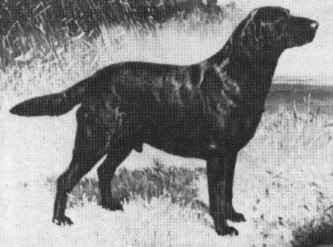
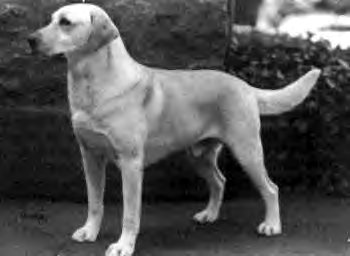
Another great from the past was CH Shamrock Acres Light Brigade. “Briggs was an outstanding show dog and sire. He produced 93 AKC Champions and won 12 Best in Show awards and 75 Sporting Group placements.” Compared to show dogs today he had longer legs and less substance, but look at those shoulders and the balance! I’d bet he moved exceptionally well.
Additionally, many people just want a Labrador and don’t breed for a specific style. The breed’s versatility and adaptability allowed it to meet many needs and yet keep it’s intelligence, friendliness, and trainability.
Choosing the Right Lab for You
When choosing between an English vs American Lab, consider your lifestyle and what you’re looking for in a dog.
- Activity Level: Do you want a more laid-back dog or an energetic exercise partner?
- Living Space: Do you have a large yard or live in an apartment?
- Time Commitment: How much time can you spend training and exercising?
- Family Situation: Do you have young children or other pets?
Remember, these are general guidelines and some dogs might be different. Always meet the dog and, if possible, its parents before deciding.
You can also check out the AKC Breed Standard to read about the “perfect” Labrador.
The differences between these types of Labs allow dog lovers to find a Lab that fits their lifestyle. Whichever you choose, you’ll have a great companion with the qualities that make Labradors one of the most popular breeds worldwide.

Named for her birthplace in Georgia, Chicka made a name for herself running in field trials.
Chicka’s early years
Her intense retrieving drive was apparent while she was still with her littermates. Her owner said, “She would whirl, twirl and do somersaults” to retrieve anything thrown.
At four months she won a Puppy Stake against dogs more than twice her age. She did it by swimming across a large pond full of sticks and lily pads.
Her career
At a bit over two years old, she won the first of three Double Headers. In all, she qualified six times for the National Open and seven times for the National Amateur. She was a finalist four times.
In 2004, she won the National Amateur with her owner, Lynne, handling.
Lynne described the fifth series, “There were 4 marks, 2 of which were flyers and 2 dead bird-retired marks. The longest of which was about 200 yards. The flyers were visually close to each other and a high number of dogs had to be handled. It was a beautiful series set in a hay bale field with interesting terrain but the hay bales did confuse the dogs. We had all kinds of weather…from hot to cold and rain to sun, plus difficult winds. Additionally, it was a ‘mixed bag’ of birds, which is the most difficult form of retrieval in terms of game. The dogs become keyed into the scent of the first bird retrieved. Then have to re-focus on very different scent for subsequent birds of different species. It really was a make or break series.”
Injuries
What makes Chicka’s career even more impressive is the injuries she overcame. In one surgery, she had two ruptured lumbar spinal discs removed. Another surgery was a total replacement of her right hip. She spent more time in rehab than in training in the 2-1/2 years before her National win.
Chicka was also featured in a magazine for disabled sports men and women.
Pedigree
| 2xNAFC 2xCNAFC FC CFC Ebonstar Lean Mac | CNFC CNAFC Waldorf’s High Tech | CFC Rascal’s Super Spud |
| Itch’s Flying Tiger | ||
| Ebonaceae Princess WCX QAA | Trieven El Conquistador | |
| Skookum’s Sky Raider | ||
| Lazer’s Razor Sharp MH | FC AFC Donnybrooks Rocky Road | FC AFC Connies Little Thunder |
| Raintree Farms Mint Julep | ||
| Snakes Midnight Lazer MH | Spider Man II | |
| Snake’s Whistling Wind |
Famous relatives
Chicka was sired by Ebonstar Lean Mac and out out of Lazer’s Razor Sharp MH. She also descends from NFC 2xNAFC Super Chief (Hall Of Fame) and his relatives:
- FC AFC Air Express HOF
- FC AFC Ithin’ To Go
- FC AFC CFC Trieven Thunderhead HOF
- CNFC FC Wanapum Darts Garbo
- Super Powder QAA
There are many other great Labs in her pedigree, including National Field Champions and National Amateur Field Champions. Some have also been inducted into the Hall of Fame.
Plus there are show champions, English imports and dual champions, including 3xNFC CFC Dual Ch Shed of Arden HOF.
Although she may be the best known dog in her litter, there are other titled dogs. Her brother, Law Abiding Ezra, earned his FC and AFC plus an Obedience Trial Championship (OTCH). Ezra also sired a daughter who earned her OTCH plus UDX2 and MH.
Other siblings have field championship and/or hunt test titles. Then you could spend hours looking through the list of half-siblings sired by her father.
NAFC FC Chickamauga Choo Choo
Whelped: May 21, 1996
Died: Dec 5, 2008
Owners: Lynne and Mac DuBose, Hillsborough, NC
Breeders: Vincent and Phyllis Garner
Registration: SN36231305
Accomplishments:
34 Derby points
QAA before 2 years old
3x Double Header winner
64.5 Open points
120 Amateur points
National Amateur Field Champion
2012 Retriever Hall of Fame
Glossary:
CH – Show Championship
FC – Field Championship
AFC – Amateur Field Championship
NFC – National Field Champion
NAFC – National Amateur Field Champion
CFC – Canadian Field Championship
CAFC – Canadian Amateur Field Championship
CNFC – Canadian National Field Champion
Double-header – to win both the Open and Amateur stakes at the same field trial
QAA – Qualified All-Age
MH – Master Hunter
OTCH – Obedience Trial Championship
UDX – Utility Dog Excellent obedience title
HOF – Hall of Fame

“Every good hunter is uneasy in the depths of his conscience when faced with the death he is about to inflict on this enchanting animal.”
~ Jose Ortega y Gasset
In Hunting Retriever magazine, Rich Carpenter discussed why some people run their dogs in hunt tests. And yet they don’t hunt.
I’d like to expand on that a bit and ask, Why did you choose a retriever if you don’t hunt? There are lots of other breeds and many make sweet and loyal companions.
Why choose a retriever?
If you own a retriever and don’t hunt, are you doing your dog a disservice?
I remember the first time my dog, Chip, retrieved a freshly killed bird. He brought it back to me with a look that plainly said, “Wow! THIS is what I was meant to do!” He had retrieved many things before, but this time it was different. His instincts had kicked in.
He would still retrieve balls and frisbees, but he loved retrieving birds.
Have you considered learning to hunt?
Speak up if you would like to hunt, but don’t know how to or where to go. Many hunters are passionate about their sport and would be glad to talk to you about it. If you have a good attitude and a sincere desire to learn, you might be able to talk one of them into an invite on one of their hunts.
But maybe you don’t hunt because you might have to kill something. And you don’t want to do it. I understand. Many hunters feel a pang when they’ve killed an animal or a bird, but it is the way of nature.
We are so far removed from our food, that we often forget those steaks we bought were once a cow. A peaceful, grass-eating animal. We don’t think about that because we didn’t participate in killing that animal or cutting it into pieces to store in our refrigerator.
And that’s okay. The cows and pigs and chickens on display in the grocery store were bred and raised for exactly that.
Wild game is different
On the other hand wild game often die a violent death – sometimes being eaten alive. Or it could be injured and, if unable to fend for itself, die a slow death from starvation.
As hunters, we owe it to the game we hunt, to provide a quick, clean death. But when the shot goes awry and a bird is injured, a well-trained retriever is the best bet to find that bird and save it from a painful, lingering death.
Why we hunt
Do we always kill when we go hunting? No, and that’s part of the fun of it. When the birds just aren’t flying, we still get to watch the rosy hues of sunrise with our 4-footed friend. Or maybe the birds are flying, but zig just as we shoot and miss. Then the dog gives us that astonished glance that questions why we would do that when he is ready to go.
Rich Carpenter quoted more from Gassett, “One does not hunt in order to kill; on the contrary, one kills in order to have hunted… with all the extras that this carries with it: the immersion in the countryside, the healthfulness of the exercise, the distraction from his job.”
So many things you miss by not getting out in the field with your dog. Think about it!
Header image courtesy TheOtherKev via Pixabay
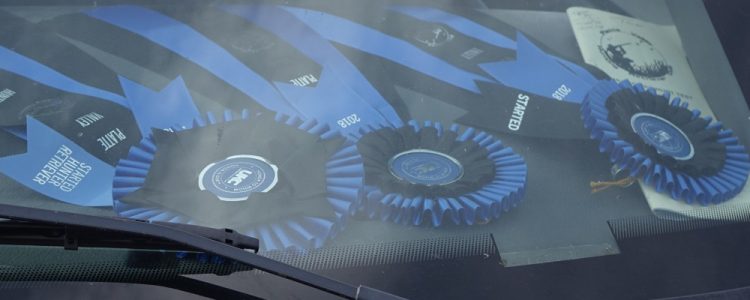
Completing Tisket’s hunt test title
We ran in the hunt test at Indian Meadows in Snyder, Colorado. Tisket only needed two passes to complete her Started hunt test title (SHR), so she was entered both days.
The first land mark on Saturday was in fairly heavy cover and a bit shorter than what we’d practiced. Many dogs, including Tisket, overran the mark and had to work their way back, while honoring their noses. Tisket ran back and forth where she thought the bird had dropped, to try to pick up the scent. You could tell when she caught the scent because her nose looked like it had been snagged by a fishhook.
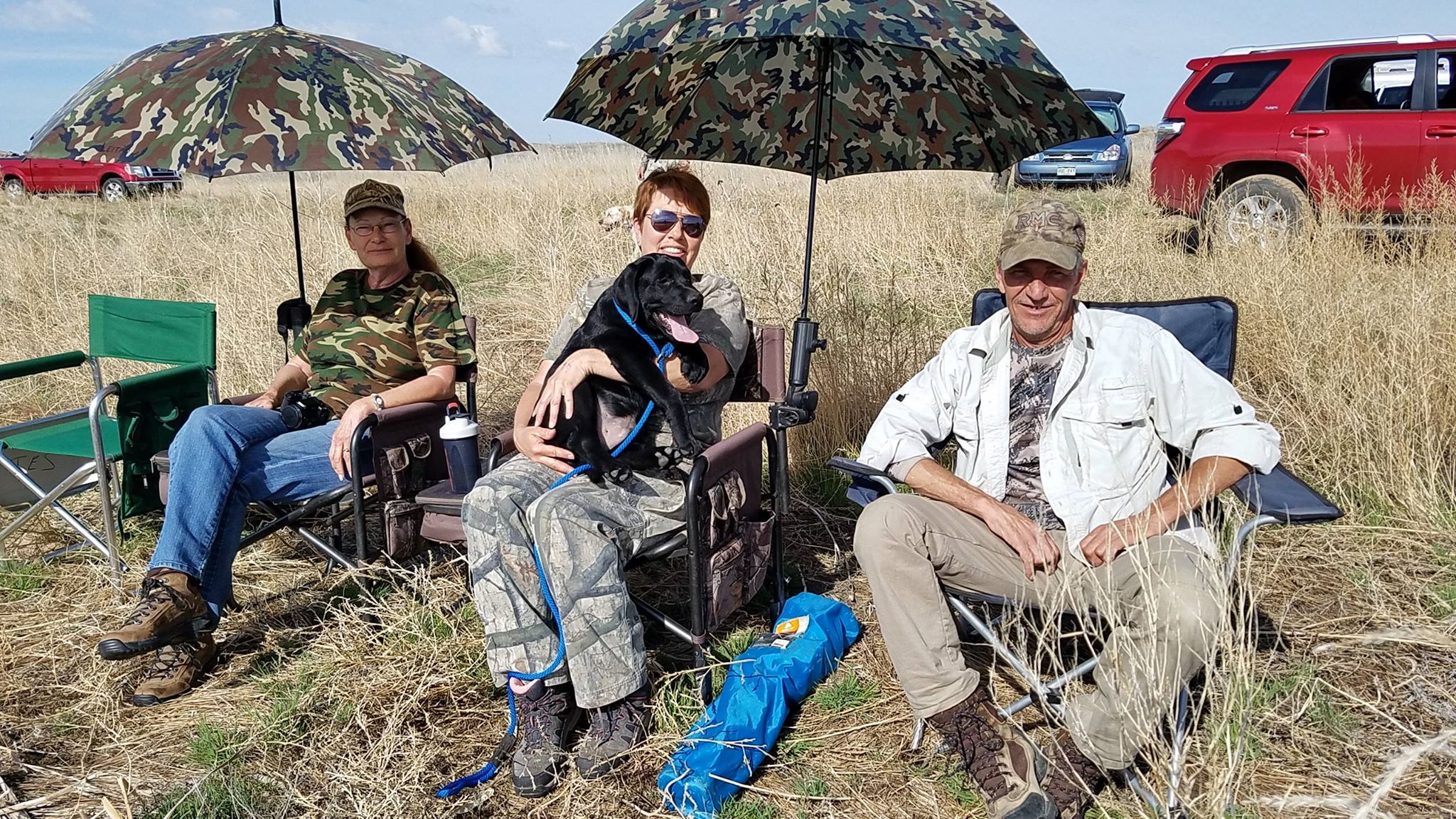
She ran straight to the second mark – “stepped on it” – and brought the bird back to me. The land marks were done, next up were the water marks!
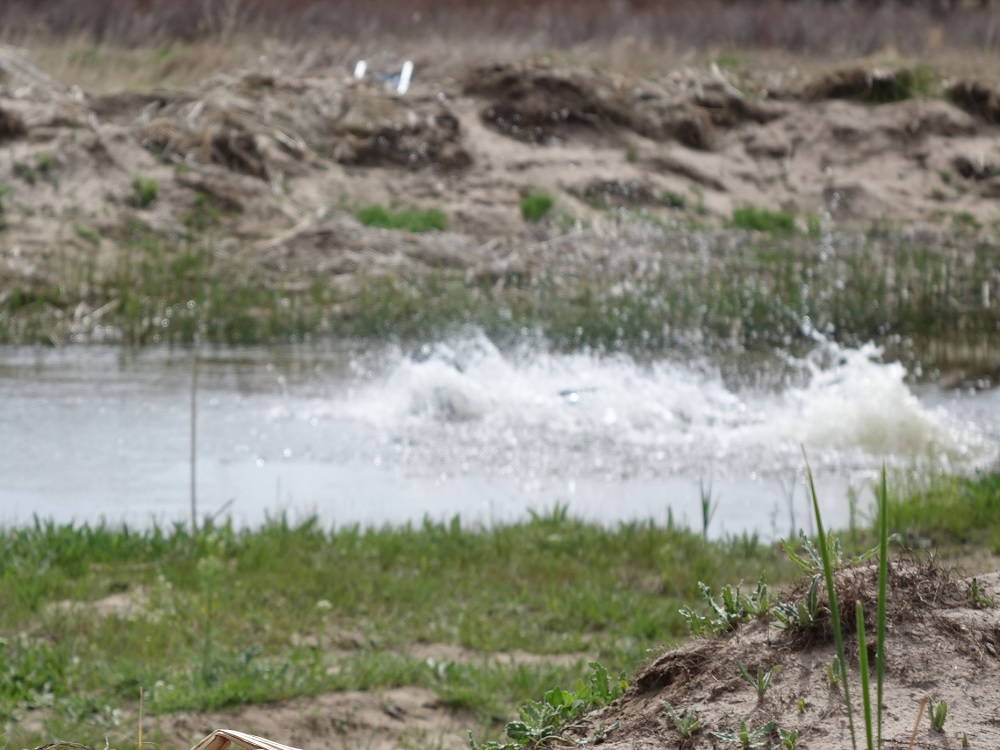
The water marks were set up at the end of a spit of land. The first mark was across a channel into a marshy area to give a slight splash when the birds landed. The second mark was to the left in open water on a good-sized pond.
Tisket did great on the first mark, except she had to check the decoys on the way back. She never dropped her bird, but had to bump each decoy with her nose to make sure it wasn’t real.
The open water swim was out and back, despite the slight chop due to the wind.
Another pass for Tisket!
Wynk’s first hunt test
On Sunday we started with the water marks and Tisket’s daughter, Wynk, got to run for the first time.
Both marks were across a channel – wider than yesterday’s location – and onto a sandy bank with sparse grass.
Tisket was out and back quickly on both birds. Very nice retrieves.
Wynk came out raring to go! There wasn’t room for a running start, but she leaped into the water with a big entry and picked up each bird in turn. No time wasted hunting around – she knew exactly where her birds were.
On to the land marks for both girls!
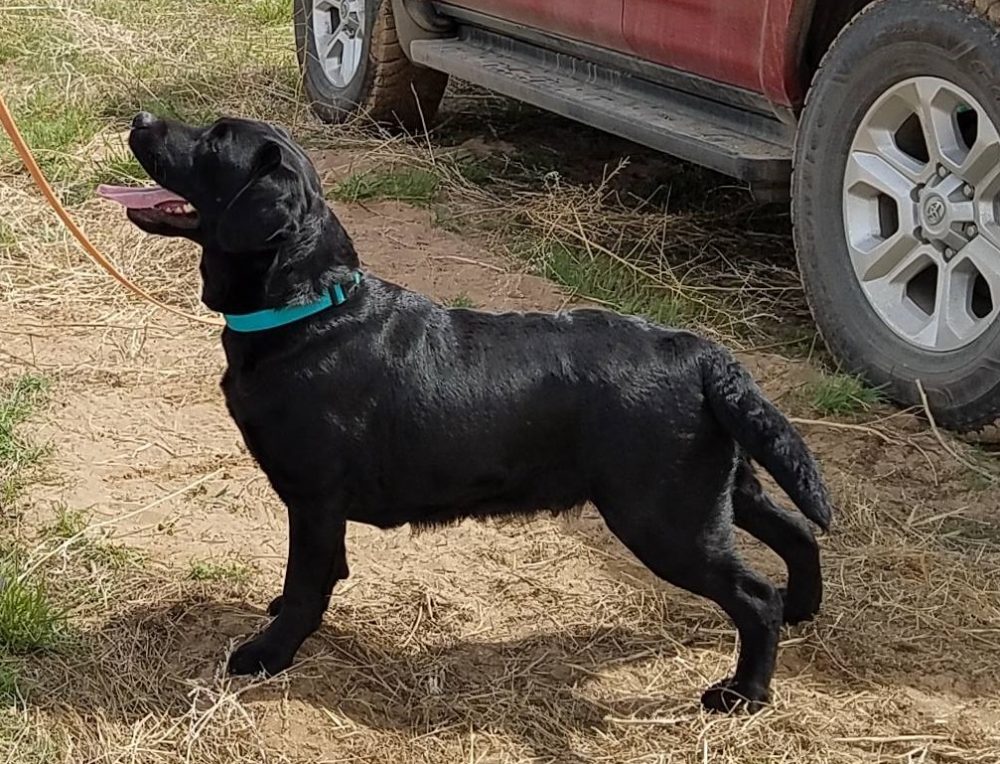
It was hot and starting to get muggy with a thunderstorm brewing to the west. Didn’t bother either girl in the least.
Tisket ran first again. Out, scoop up the bird and back in no time. The second bird landed in a little swale and she overran it by a yard or two. But she turned quickly, scooped it up and brought it back to me. No question she picked up another pass and that was enough for her title!
Wynk came out raring to go again. Good, because I was wilting with the heat and humidity. Although she’s not very tall, she motored her way to each mark and surprised a few people with her speed. Out and back quickly on the first mark. Slide and turn as she tried to pick up the second bird without stopping. No question; she likes this game!
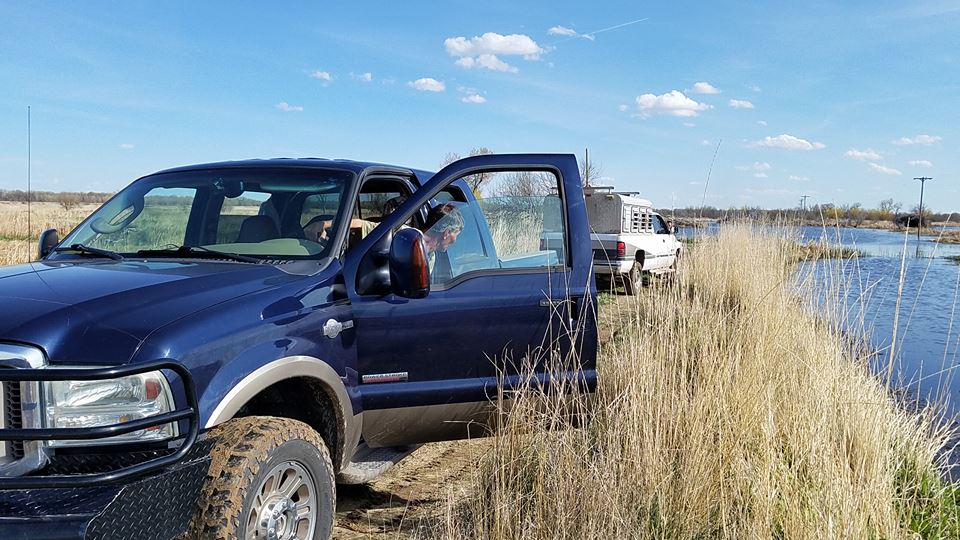
Overall, great weekend.Platte Valley HRC’s club members, helpers, and judges did a good job.
Tisket finished her title, Wynk got her first pass and my truck didn’t stay stuck for long!

